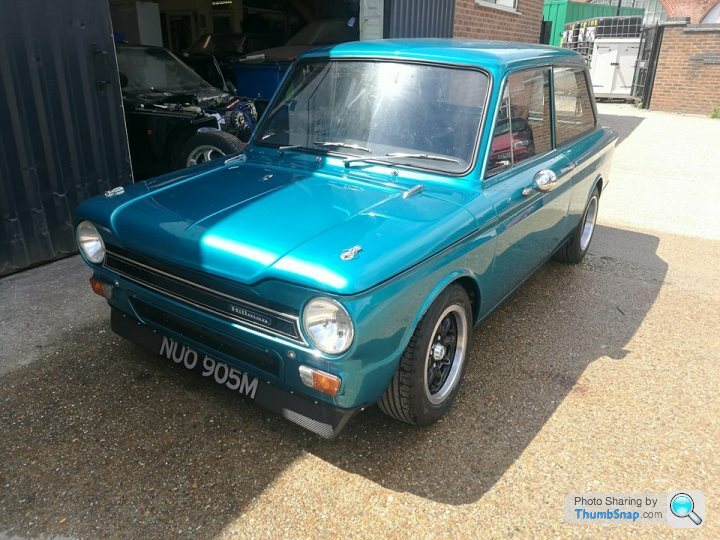1973 Hillman Imp 1.6 De Luxe...........wait, what??!
Discussion
Sometimes life doesn't go the way you expect it to. Sometimes bad things happen, and sometimes good things happen. Sometimes, things happen which initially start out bad, but switch to a positive, depending on the way you look at them.
I've got a million other readers cars threads going (because I have about a million cars) and most of them are old and French. Not this one though, oh no! This one is even older.....and Scottish! So what's the crack?
Long story short (I'll do the longer ones sometime in the future), I run a small workshop specialising in restoration (mainly TVR chassis) but also tinkering in classic and modern classic cars, as well as a plethora of kit cars and specials. A long, long time ago, a young man by the name of Tim came to me on the recommendation of a friend, and said that he had a Hillman Imp, and wanted to put an engine in it. It didn't have an engine fitted, it was basically a rolling shell he'd bought from a field:
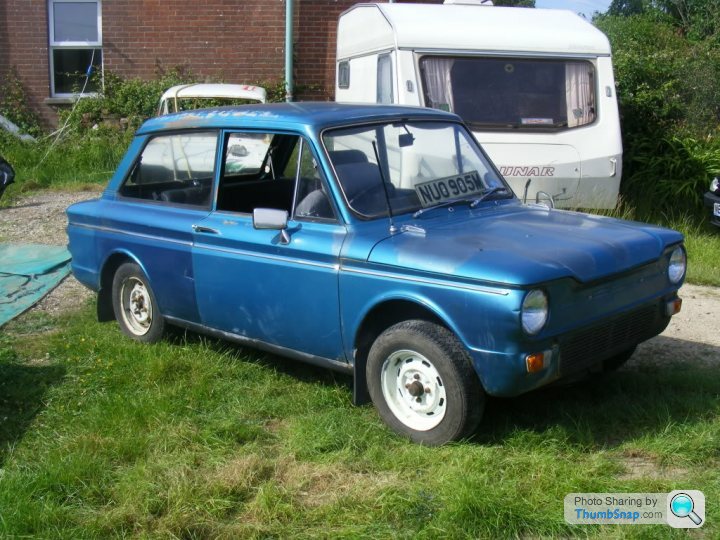
He'd lusted after an Imp for many years, and this was the realisation of a dream! He asked if he should put a motorbike engine in, to which my reply (based solely on my own opinion) was no, you shouldn't. Bike engined cars are awesome on the track, and bike engines are just better than car engines in terms of technology. But on the road, where this thing was going to spend most of its life, the bike engine would be a pain. No reverse, little to no torque at low revs (BEC's often need revving to 5-6k revs, just to find the biting point as they're no longer trying to move 200kg of Kawasaki around). My advice was use a car engine, if it is to be a road car with very occasional track use. Next engine to be dismissed was one of the Imp's original innovative features, the Coventry Climax-based all alloy lump. Would be the cheapest in terms of a package, but would need serious tuning to achieve the 100bhp goal we had set. And it would be unlikely to be a reliable 100bhp, or certainly not as reliable as an engine designed to run 100bhp in the first place. That all said, both Tim and I wanted to retain the 'Impness' of the car. We've had literally 1,374 people ask us "Why didn't you fit a Subaru XXX or a Honda YYYY or a Dacia Sandero V8?" Well, the reason is because, at the end of the day, an Imp is what Tim desired, and if he ended up with a V6-powered spaceframe clad with Imp bodywork.....well, that's not really an Imp any more, cool as it may be. So it needed to still be 'Imp' in its DNA, even if the engine wasn't. And of course, we know more than most that if we went cutting up an Imp shell in a structural manner, we'd be well into the realms of the dreaded IVA test. We didn't want that!
And so, I had a brainwave. It's probably know by a few people on here that I have a serious condition called
'Likesrattlyoldfrenchitus'. This condition led to me considering a tenuous link - Peugeot. The Rootes group was bought out by Peugeot in the late 70's, Talbot name and all. I knew from my PSA obsessions that Peugeot used the Simca-derived XY engine (aka the suitcase, because it lays down flat) in the Peugeot 104, Talbot Samba, early 205 and early BX models, among others. They were available in 1360cc, and would yield around 80bhp. All alloy, quite light, sounded god-awful but generally quite durable and peppy. Trying to find one might be tricky, but I swear I'd seen the conversion done before. And so I Googled frantically 'Peugeot engined Hillman Imp' and found nothing on the XY engine. Balls.
What I did find, was a small thread on a forum regarding a Scandinavian ice-racing series. In that series, a limit of 1399cc had been set, and apparently the cars that were tearing up the field were Hillman Imps being pushed along by Peugeot/Citroen TU3 engines lifted from the AX GT and 205 XS. 85bhp, similar basic weight to the Climax and pretty tough. I didn't realise they'd fit, as they sit bolt upright, but a quick trawl of some Imp forums revealed that they did - just!
Could we find an AX GT engine? Could we feck! But the TU came in many different flavours, and one of these was the TU5 in the Saxo VTR 1.6 unit. 90bhp as standard, and pretty tough. Lots of midrange torque (perfect for munching Imp transaxles) and they engines were cheap. Hell, even the cars were cheap, so we bought a car!:
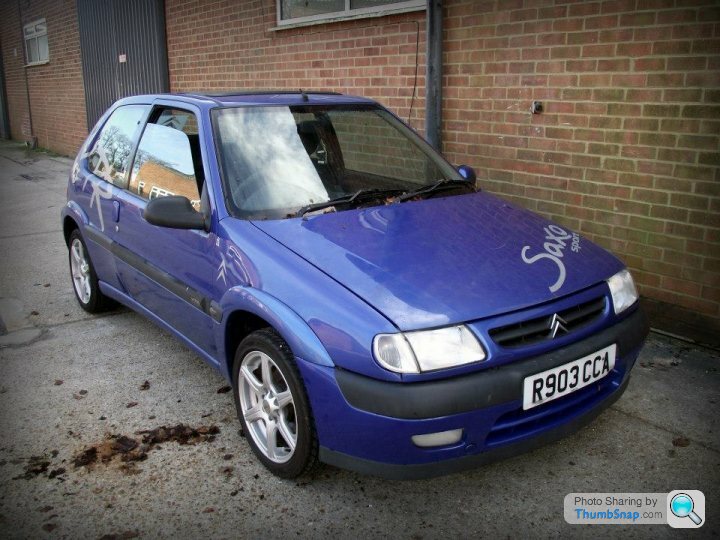
Only drawback, is that the TU5 only came in iron block flavour, unlike the all alloy TU3 fitted to the AX GT. With a weight penalty of around 30kg, we'd need to be clever to stop the car handling like a pig. In retrospect, the perfect engine would have been the TU2J2 fitted to the S1 106 Rallye, but they're even rarer. And more expensive.
The Saxo came with 120,000 on the clock, and no MoT. We popped it on the dyno before the engine came out, where it continued the Saxo tradition of bettering its book power figures (every Saxo to date has produced more power on the dyno than the book figures state!) 95bhp was the number, and the graph was strong (even if the radiator was not!)
The engine was duly removed and the Saxo discarded.
Now we had a square peg (a TU engine), and a round hole (an Imp). But the TU5 would get us to the 100bhp marker we set, and provide it reliably. So how to you make a square peg fit a round hole? Simple, you improvise:
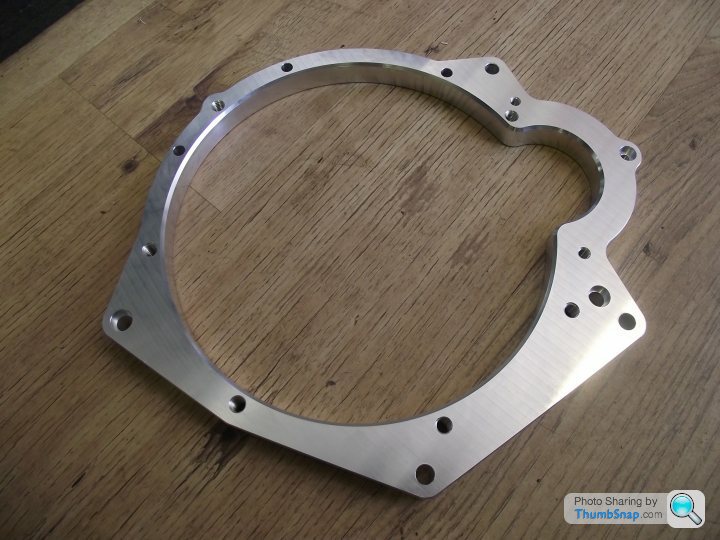
We spent a LONG time to designing that!
Now we had a TU engine and a way of mounting it to an Imp transaxle. We came up with a hybrid clutch using Sierra bits and Saxo bits, along with a flywheel from a 106 Quicksilver. We had Reg Patten build a mk3 gearbox (the strongest casing) with a Ford-splined input shaft, to allow the Sierra driveplate to fit. Then we used Lotus Elan roto-couplings to connect the box to 1in Imp Sport driveshafts.
To push the TU5 engine into the 100+ club, we fitted some Honda Fireblade bike carbs (the standard injection system wouldn't fit), as well as a Newmans PH3 fast road camshaft, and Raceland 4-2-1 stainless exhaust manifold (standard VTRs use what is basically a 1.1 exhaust, possibly to strangle them a bit to bring insurance groups down). The ignition is distributorless, and managed by a Megajolt box mounted in the back. To keep the engine cool, an MGF radiator was installed up top, and I took and angle grinder to the front end to create a kind of 'custom' grille. Twin cooling fans keep the temps in check, and Evans Waterless Coolant circulates the pipework plumbed through the cabin (as the original Imps had radiators mounted in the engine bay) which is heat-wrapped and hidden below handmade GRP panels, carpeted to take the eye away from them. The rear seats are no longer there, though I would put some in if the coolant pipes didn't go there.
The rest of the Imp was also given similar treatment. All suspension was stripped, shot blasted and painted in POR15 before before fitted out with polybushes. The front drum brakes were binned in favour of Fiesta mk1 discs, Goodridge braided hoses were fitted all round, and the steering tie rods were upgraded to the Imp Club adjustable types. The body shell was fully resprayed in Vauxhall Karabic bue. Why? Because Aquarius metallic is harder to mix up, and the Vauxhall colour is 99.5% the same as the fairly rare Aquarius, just much easier to deal with if it needs any future resprays (which it does, already - more on that later!) We had the pinholes for the side mouldings smoothed over, along with the rear panel where we removed the bumper mounts and starter handle hole. Speaking of the rear panel, we braced it and fabricated an extended engine mounting boss, so we could utilise all the original Imp mounting points. The engine cover is a carbon-fibre piece, as is the front spoiler.
The entire build can be seen here in this blog we did along the way (apologise for some of the pictures - I got carried away with Picasa back in the days!)
And so where do we end up now? Well, life doesn't always go the way you plan. And so, as I said when I started the thread, we're at that point. Tim no longer owns the Imp, I do. Life came Tim's way, and shat at his doorstep. The alternative was to break the car up, as Tim couldn't stomach seeing someone else enjoying the fruits of his cash and our labour. If I didn't take it, nobody would. I couldn't bear to see the Imp come this far and not cross the finishing line. We'd covered around 100 test miles since January 2016, but still had (and still have) plenty of kinks and creases to iron out.
Yesterday, me and my wife took it to the Seven Stars near Petersfield, to see if we could take a run out in it without issue. We got there and back, though there are still issues! Even so, I took some pics at the end and this is where we're currently at:

The interior is half finished. I don't like the seats (have more period ones ready to go in) and the dashboard needs more of a dashboard! The binnacle itself is a custom-made six-dial version of a Stiletto dash, finished in black crackle paint (naturally). It comprises an oil pressure gauge (which doesn't work properly), a coolant temp gauge (which doesn't work properly), a speedo (which doesn't work properly), a rev counter (which DOES work!), a fuel gauge (which DOES!) and finally a volt gauge (which works, but is only there because it came in the box - will likely get replaced with an AFR gauge or something):
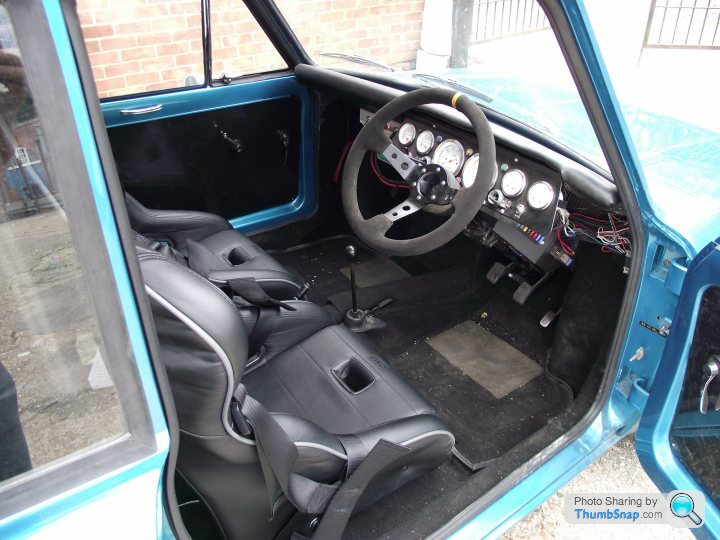
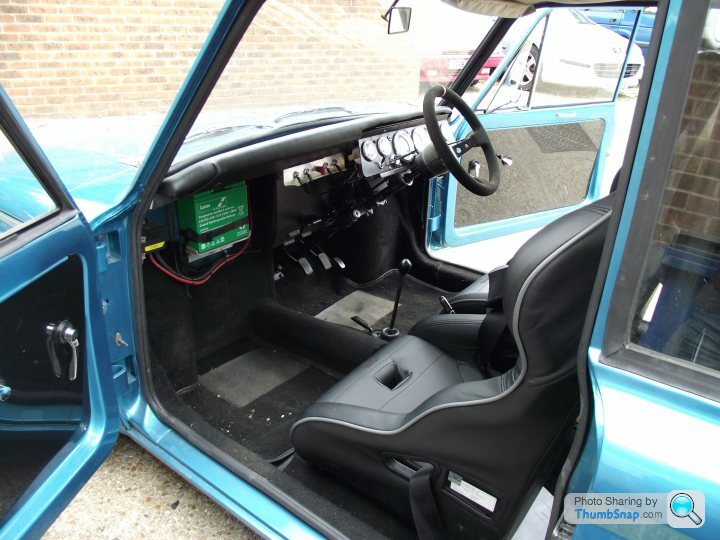
The 'frunk' (front-trunk) would usually be loaded with a spare wheel, a heater blower motor, a fuel tank and not much else. Now, it houses the radiator and cooling fans, an alloy fuel tank (which sits on a custom-strut brace), the electric fuel pump and pressure regulator. The two areas are split by a plastic bulkhead, which is there to prevent the radiator heating up the fuel tank. The spare wheel well has been opened up to allow warm air to pass through, and the lourves in the wheel arches allow the low-pressure air in the wheel arches to suck the high-pressure air out........when the car is moving anyway!) The splitter is carbon fibre, as mentioned, and the grille is an original Imp grille we cut up and hid some mesh behind (had the idea on the bog one night!) The headlamps are halogen-converted:
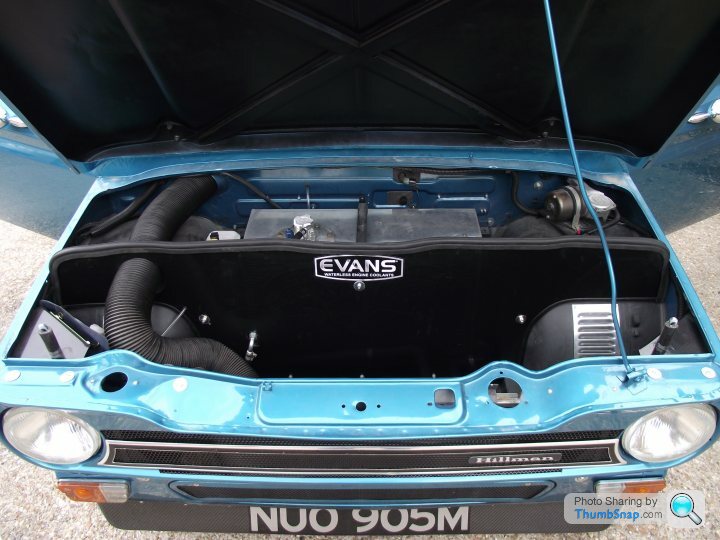

The business end! The Citroen TU5 lump sits with masses of space either side of it, as the original Climax lump laid flat. To fit it in, we had to remove the parcel shelf skin, but otherwise it fits fairly well, and nothing structural needed to be hacked out, which was important to us. The rear panel was a standard Imp piece which we customised into one being able to take a Spoox Peugeot 106 Grp N mounting plate. Spoox carbon fibre timing covers replaced the plastic (must have saved, ooh - 0.012kg there!). The gearbox is a standard mk3 box fitted with a custom input shaft, and uses original Imp mountings. We added a Mini stabiliser bar to the offside of the engine to aid stability, and the rear panel is braced triangularly, just for a bit of additional torque-resistance (we're going from 50lbft odd to around 100lbft):
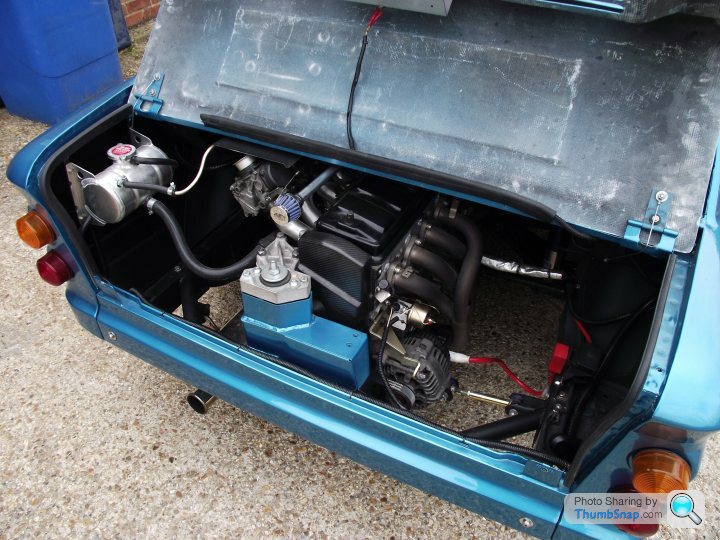
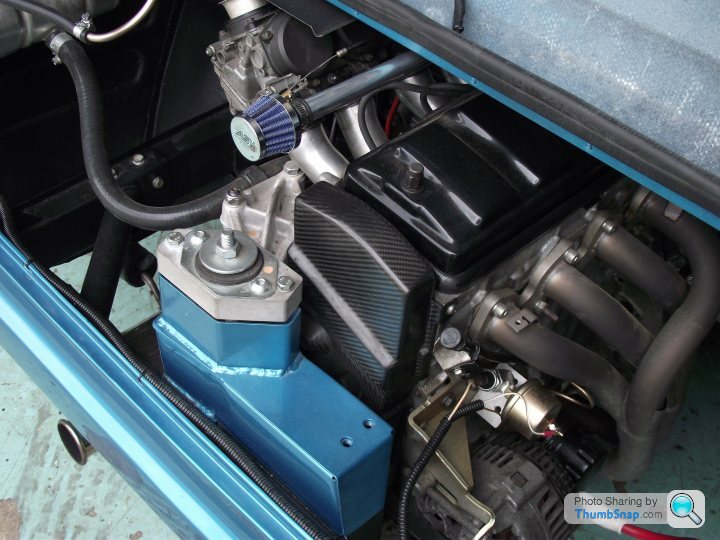
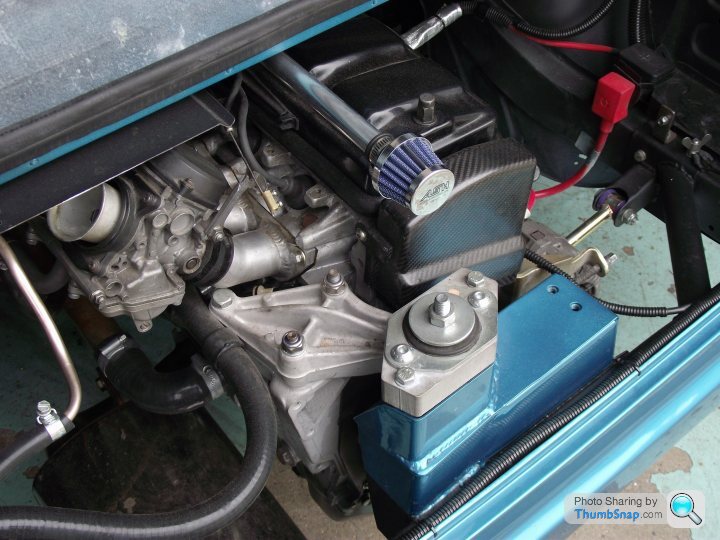
To compensate the weight gain of the engine, the battery and radiator have moved off to the front. The Longlife exhaust system is tiny, and weighs very little. The carbon-fibre engine cover weighs around 1.5kg - around 5kg less than the original. Access to the engine is gained obviously though the engine lid, but can also now be gained through the interior of the car. This sound-deadening box we made from Celotex board, and insulated it against heat. It's mounted on a rear stiffening brace, which also houses the seat belt harnesses:
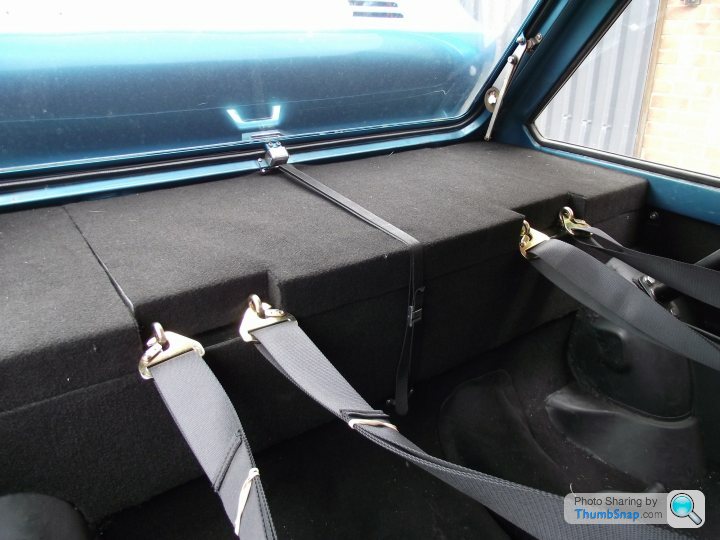
There is also a safety devices roll bar fitted.
So what's it like to drive? Erm, frantic! That would probably the be the best way to describe it. In terms of performance, it's probably on par with a 205 GTi 1.9 or a mk2 Golf GTI 16v - that kind of level, only with a lot more noise! The gearing is the weak link, really. It's only 4-speed, and the final drive is very short. 2000rpm equates to 30mph in top gear, and each 1000rpm increase equates to an additional 15mph, so 6000rpm is 90mph. Being that the limiter is at 7000rpm, top speed is basically a ton, so it's not exactly....refined. It pulls well, makes a nice old skool carb induction roar and plenty of soft pops from the exhaust on the overrun. It's very easy to drive in traffic, all controls are light and easy to use and it idles sweetly.
Handling? It's good! So much communication through the steering and through the car itself. You can feel the weight shifting around, but it's all well-mannered. That's at 7/10ths - on a qualifying lap it might be more of a handful, but it kept up with a new shape Mini being driven fairly briskly recently. Probably enough to make the driver look in the rear view mirror and think "Eh?!"
The gearchange should be sweet, but isn't. More work needed here as it makes some awful noises when coming on and off the clutch, and it tends to lose its oil. We always knew it would take a while to iron out the creases, and we suspect the concentric slave cylinder we fitted is to blame.
The brakes are equally as bad. So much so, I'm currently looking at a pair of old Wilwoods and some 5mm plate steel.
The suspension is surprisingly compliant. Riding Gaz coilovers at the front and Gaz adjustable dampers with standard springs at the back, it rides quite well. The suspension was quite advanced for a small car of the time, and it shows even today, where it rides better than something like a Metro, designed nearly 20 years later.
On the whole, it's a lot of fun. I love innovative, often overlooked cars, and I always wanted to own an Imp. The Imp was the first car to have folding rear seats (which I've removed) and using an all-alloy engine in a compact car was certainly unusual (removed that too). But on the whole, it's a good giggle and I'm looking forward to tinkering. Next step, new seats (I don't like the ones currently fitted that much) and I'll be ditching the gold wheels (again, not my cup of tea - Tim loved them though). Oh, and the engine needs to come back out to have a look at that clutch/gearbox issue. I'm aiming to get it to some shows and meets this summer though, and a couple of mags have been chasing for a feature for a while.
Cheers for reading the 'short' version I'll try to keep this updated!
I'll try to keep this updated!
I've got a million other readers cars threads going (because I have about a million cars) and most of them are old and French. Not this one though, oh no! This one is even older.....and Scottish! So what's the crack?
Long story short (I'll do the longer ones sometime in the future), I run a small workshop specialising in restoration (mainly TVR chassis) but also tinkering in classic and modern classic cars, as well as a plethora of kit cars and specials. A long, long time ago, a young man by the name of Tim came to me on the recommendation of a friend, and said that he had a Hillman Imp, and wanted to put an engine in it. It didn't have an engine fitted, it was basically a rolling shell he'd bought from a field:

He'd lusted after an Imp for many years, and this was the realisation of a dream! He asked if he should put a motorbike engine in, to which my reply (based solely on my own opinion) was no, you shouldn't. Bike engined cars are awesome on the track, and bike engines are just better than car engines in terms of technology. But on the road, where this thing was going to spend most of its life, the bike engine would be a pain. No reverse, little to no torque at low revs (BEC's often need revving to 5-6k revs, just to find the biting point as they're no longer trying to move 200kg of Kawasaki around). My advice was use a car engine, if it is to be a road car with very occasional track use. Next engine to be dismissed was one of the Imp's original innovative features, the Coventry Climax-based all alloy lump. Would be the cheapest in terms of a package, but would need serious tuning to achieve the 100bhp goal we had set. And it would be unlikely to be a reliable 100bhp, or certainly not as reliable as an engine designed to run 100bhp in the first place. That all said, both Tim and I wanted to retain the 'Impness' of the car. We've had literally 1,374 people ask us "Why didn't you fit a Subaru XXX or a Honda YYYY or a Dacia Sandero V8?" Well, the reason is because, at the end of the day, an Imp is what Tim desired, and if he ended up with a V6-powered spaceframe clad with Imp bodywork.....well, that's not really an Imp any more, cool as it may be. So it needed to still be 'Imp' in its DNA, even if the engine wasn't. And of course, we know more than most that if we went cutting up an Imp shell in a structural manner, we'd be well into the realms of the dreaded IVA test. We didn't want that!
And so, I had a brainwave. It's probably know by a few people on here that I have a serious condition called
'Likesrattlyoldfrenchitus'. This condition led to me considering a tenuous link - Peugeot. The Rootes group was bought out by Peugeot in the late 70's, Talbot name and all. I knew from my PSA obsessions that Peugeot used the Simca-derived XY engine (aka the suitcase, because it lays down flat) in the Peugeot 104, Talbot Samba, early 205 and early BX models, among others. They were available in 1360cc, and would yield around 80bhp. All alloy, quite light, sounded god-awful but generally quite durable and peppy. Trying to find one might be tricky, but I swear I'd seen the conversion done before. And so I Googled frantically 'Peugeot engined Hillman Imp' and found nothing on the XY engine. Balls.
What I did find, was a small thread on a forum regarding a Scandinavian ice-racing series. In that series, a limit of 1399cc had been set, and apparently the cars that were tearing up the field were Hillman Imps being pushed along by Peugeot/Citroen TU3 engines lifted from the AX GT and 205 XS. 85bhp, similar basic weight to the Climax and pretty tough. I didn't realise they'd fit, as they sit bolt upright, but a quick trawl of some Imp forums revealed that they did - just!
Could we find an AX GT engine? Could we feck! But the TU came in many different flavours, and one of these was the TU5 in the Saxo VTR 1.6 unit. 90bhp as standard, and pretty tough. Lots of midrange torque (perfect for munching Imp transaxles) and they engines were cheap. Hell, even the cars were cheap, so we bought a car!:

Only drawback, is that the TU5 only came in iron block flavour, unlike the all alloy TU3 fitted to the AX GT. With a weight penalty of around 30kg, we'd need to be clever to stop the car handling like a pig. In retrospect, the perfect engine would have been the TU2J2 fitted to the S1 106 Rallye, but they're even rarer. And more expensive.
The Saxo came with 120,000 on the clock, and no MoT. We popped it on the dyno before the engine came out, where it continued the Saxo tradition of bettering its book power figures (every Saxo to date has produced more power on the dyno than the book figures state!) 95bhp was the number, and the graph was strong (even if the radiator was not!)
The engine was duly removed and the Saxo discarded.
Now we had a square peg (a TU engine), and a round hole (an Imp). But the TU5 would get us to the 100bhp marker we set, and provide it reliably. So how to you make a square peg fit a round hole? Simple, you improvise:

We spent a LONG time to designing that!
Now we had a TU engine and a way of mounting it to an Imp transaxle. We came up with a hybrid clutch using Sierra bits and Saxo bits, along with a flywheel from a 106 Quicksilver. We had Reg Patten build a mk3 gearbox (the strongest casing) with a Ford-splined input shaft, to allow the Sierra driveplate to fit. Then we used Lotus Elan roto-couplings to connect the box to 1in Imp Sport driveshafts.
To push the TU5 engine into the 100+ club, we fitted some Honda Fireblade bike carbs (the standard injection system wouldn't fit), as well as a Newmans PH3 fast road camshaft, and Raceland 4-2-1 stainless exhaust manifold (standard VTRs use what is basically a 1.1 exhaust, possibly to strangle them a bit to bring insurance groups down). The ignition is distributorless, and managed by a Megajolt box mounted in the back. To keep the engine cool, an MGF radiator was installed up top, and I took and angle grinder to the front end to create a kind of 'custom' grille. Twin cooling fans keep the temps in check, and Evans Waterless Coolant circulates the pipework plumbed through the cabin (as the original Imps had radiators mounted in the engine bay) which is heat-wrapped and hidden below handmade GRP panels, carpeted to take the eye away from them. The rear seats are no longer there, though I would put some in if the coolant pipes didn't go there.
The rest of the Imp was also given similar treatment. All suspension was stripped, shot blasted and painted in POR15 before before fitted out with polybushes. The front drum brakes were binned in favour of Fiesta mk1 discs, Goodridge braided hoses were fitted all round, and the steering tie rods were upgraded to the Imp Club adjustable types. The body shell was fully resprayed in Vauxhall Karabic bue. Why? Because Aquarius metallic is harder to mix up, and the Vauxhall colour is 99.5% the same as the fairly rare Aquarius, just much easier to deal with if it needs any future resprays (which it does, already - more on that later!) We had the pinholes for the side mouldings smoothed over, along with the rear panel where we removed the bumper mounts and starter handle hole. Speaking of the rear panel, we braced it and fabricated an extended engine mounting boss, so we could utilise all the original Imp mounting points. The engine cover is a carbon-fibre piece, as is the front spoiler.
The entire build can be seen here in this blog we did along the way (apologise for some of the pictures - I got carried away with Picasa back in the days!)
And so where do we end up now? Well, life doesn't always go the way you plan. And so, as I said when I started the thread, we're at that point. Tim no longer owns the Imp, I do. Life came Tim's way, and shat at his doorstep. The alternative was to break the car up, as Tim couldn't stomach seeing someone else enjoying the fruits of his cash and our labour. If I didn't take it, nobody would. I couldn't bear to see the Imp come this far and not cross the finishing line. We'd covered around 100 test miles since January 2016, but still had (and still have) plenty of kinks and creases to iron out.
Yesterday, me and my wife took it to the Seven Stars near Petersfield, to see if we could take a run out in it without issue. We got there and back, though there are still issues! Even so, I took some pics at the end and this is where we're currently at:

The interior is half finished. I don't like the seats (have more period ones ready to go in) and the dashboard needs more of a dashboard! The binnacle itself is a custom-made six-dial version of a Stiletto dash, finished in black crackle paint (naturally). It comprises an oil pressure gauge (which doesn't work properly), a coolant temp gauge (which doesn't work properly), a speedo (which doesn't work properly), a rev counter (which DOES work!), a fuel gauge (which DOES!) and finally a volt gauge (which works, but is only there because it came in the box - will likely get replaced with an AFR gauge or something):


The 'frunk' (front-trunk) would usually be loaded with a spare wheel, a heater blower motor, a fuel tank and not much else. Now, it houses the radiator and cooling fans, an alloy fuel tank (which sits on a custom-strut brace), the electric fuel pump and pressure regulator. The two areas are split by a plastic bulkhead, which is there to prevent the radiator heating up the fuel tank. The spare wheel well has been opened up to allow warm air to pass through, and the lourves in the wheel arches allow the low-pressure air in the wheel arches to suck the high-pressure air out........when the car is moving anyway!) The splitter is carbon fibre, as mentioned, and the grille is an original Imp grille we cut up and hid some mesh behind (had the idea on the bog one night!) The headlamps are halogen-converted:


The business end! The Citroen TU5 lump sits with masses of space either side of it, as the original Climax lump laid flat. To fit it in, we had to remove the parcel shelf skin, but otherwise it fits fairly well, and nothing structural needed to be hacked out, which was important to us. The rear panel was a standard Imp piece which we customised into one being able to take a Spoox Peugeot 106 Grp N mounting plate. Spoox carbon fibre timing covers replaced the plastic (must have saved, ooh - 0.012kg there!). The gearbox is a standard mk3 box fitted with a custom input shaft, and uses original Imp mountings. We added a Mini stabiliser bar to the offside of the engine to aid stability, and the rear panel is braced triangularly, just for a bit of additional torque-resistance (we're going from 50lbft odd to around 100lbft):



To compensate the weight gain of the engine, the battery and radiator have moved off to the front. The Longlife exhaust system is tiny, and weighs very little. The carbon-fibre engine cover weighs around 1.5kg - around 5kg less than the original. Access to the engine is gained obviously though the engine lid, but can also now be gained through the interior of the car. This sound-deadening box we made from Celotex board, and insulated it against heat. It's mounted on a rear stiffening brace, which also houses the seat belt harnesses:

There is also a safety devices roll bar fitted.
So what's it like to drive? Erm, frantic! That would probably the be the best way to describe it. In terms of performance, it's probably on par with a 205 GTi 1.9 or a mk2 Golf GTI 16v - that kind of level, only with a lot more noise! The gearing is the weak link, really. It's only 4-speed, and the final drive is very short. 2000rpm equates to 30mph in top gear, and each 1000rpm increase equates to an additional 15mph, so 6000rpm is 90mph. Being that the limiter is at 7000rpm, top speed is basically a ton, so it's not exactly....refined. It pulls well, makes a nice old skool carb induction roar and plenty of soft pops from the exhaust on the overrun. It's very easy to drive in traffic, all controls are light and easy to use and it idles sweetly.
Handling? It's good! So much communication through the steering and through the car itself. You can feel the weight shifting around, but it's all well-mannered. That's at 7/10ths - on a qualifying lap it might be more of a handful, but it kept up with a new shape Mini being driven fairly briskly recently. Probably enough to make the driver look in the rear view mirror and think "Eh?!"
The gearchange should be sweet, but isn't. More work needed here as it makes some awful noises when coming on and off the clutch, and it tends to lose its oil. We always knew it would take a while to iron out the creases, and we suspect the concentric slave cylinder we fitted is to blame.
The brakes are equally as bad. So much so, I'm currently looking at a pair of old Wilwoods and some 5mm plate steel.
The suspension is surprisingly compliant. Riding Gaz coilovers at the front and Gaz adjustable dampers with standard springs at the back, it rides quite well. The suspension was quite advanced for a small car of the time, and it shows even today, where it rides better than something like a Metro, designed nearly 20 years later.
On the whole, it's a lot of fun. I love innovative, often overlooked cars, and I always wanted to own an Imp. The Imp was the first car to have folding rear seats (which I've removed) and using an all-alloy engine in a compact car was certainly unusual (removed that too). But on the whole, it's a good giggle and I'm looking forward to tinkering. Next step, new seats (I don't like the ones currently fitted that much) and I'll be ditching the gold wheels (again, not my cup of tea - Tim loved them though). Oh, and the engine needs to come back out to have a look at that clutch/gearbox issue. I'm aiming to get it to some shows and meets this summer though, and a couple of mags have been chasing for a feature for a while.
Cheers for reading the 'short' version
 I'll try to keep this updated!
I'll try to keep this updated!Thanks guys, some kind words to read on a Tuesday morning 
Had the new seats arrive yesterday, so have mostly bolted those in place. They're much smaller, and fit pretty well. I've left the passenger one out so I can get access to the engine from inside, as I have a feeling it's going to have to come out again to try and figure out what's going on with this gearbox!

Had the new seats arrive yesterday, so have mostly bolted those in place. They're much smaller, and fit pretty well. I've left the passenger one out so I can get access to the engine from inside, as I have a feeling it's going to have to come out again to try and figure out what's going on with this gearbox!
Cupramax said:
Interesting thread, my first two cars were Imps, i remember them with some affection (probably through very rose tinted specs). I seem to remember the original Coventry Climax engines were canted over to one side, how have you found enough room to have the TU upright or am i missing something, is it considerably smaller physically? Will you be fitting a new sump every 5 minutes? Mine were absolute rust buckets even back in the 80's and had the front wishbone mounts literally rust/fall out on one  that was an interesting drive home
that was an interesting drive home 
Yes, the Climax lumps were canted right over. We've removed the skin of the 'parcel shelf' which used to go in behind the rear seats (the structural framework around it is still there) and the TU engine it pretty much up against the underside of the rear member under the rear window (which is why it had to go to carbs - the original EFI setup wouldn't fit). The sump is visible underneath at the bottom, but it's not come into close contact with anything yet, and the car itself isn't that low at the rear as we've set it up for stability. That's why the front is so low. that was an interesting drive home
that was an interesting drive home 
It was pretty rusty, yeah. Has had sills, arches etc, though we farmed out all the bodywork to bodyshops in the area. A mate of mine painted it in a shed!
John_S4x4 said:
That looks like a fantastic build. Well done on all the hard work 
I've owned Imps in the past and to drive they are great cars. To carry on fixing all the problems and issues for keeping them on the road - not so great. I currently own a Davrian and am thinking about the BMW K1200 motorbike engine conversion.
Cheers. The K1200 engine looks really right in the back for an Imp. Truth be told, it wasn't an engine that came to mind when we were planning to conversion years ago. Less peaky and revvy than the usual superbike stuff, should be good!
I've owned Imps in the past and to drive they are great cars. To carry on fixing all the problems and issues for keeping them on the road - not so great. I currently own a Davrian and am thinking about the BMW K1200 motorbike engine conversion.
Shadow R1 said:
Some effort gone into that. 
You can say that again!
gregs656 said:
Your threads are always excellent. Love the Imp.
Very kind, thanksjhonn said:
Nice job! Thanks, I enjoyed reading that - I remember Imps from my youth, they had some innovative features as I recall and punched above their weight.
What does the car weigh now? Can't imagine it's more than 800kg or thereabouts - 100bhp is nice to have in something so light and nimble - it makes me think British Porsche.
It looks very well engineered - well done.
They were innovative cars, for sure. Cars that bring something new to the table always strike a cord with me, even if they're much maligned. Ironic thing is I've removed some of the innovation by whacking an iron block in it!What does the car weigh now? Can't imagine it's more than 800kg or thereabouts - 100bhp is nice to have in something so light and nimble - it makes me think British Porsche.

It looks very well engineered - well done.

Weight? Not sure. Want to find out though! Should guess its around 750-800kg wet, so yeah 110bhp or whatever's probably giving it 140bhp/ton or so.
Mr Tidy said:
Fantastic write-up OP!
I love reading threads like this - seemingly random collection of parts beautifully put together to make something really unique!
Hope we get some future updates.
We've got a lot of experience with kit cars, and I'm originally a car spec/history geek who also used to work in car parts, so I often get ideas about what could fit here and there.I love reading threads like this - seemingly random collection of parts beautifully put together to make something really unique!

Hope we get some future updates.
I'll update it with some more details and images of various aspects sometime soon. There's loads I've missed out, like the Toyota MR2 SW20 throttle linkage!
HerbertD said:
Loving the concept as I went through a similar process some years ago with a Ford CVH 1600 engine shoehorned into a Sunbeam Stiletto. Went well, but handling was challenging to say the least. I posted some details & photos of this some years ago : http://www.pistonheads.com/gassing/topic.asp?t=125...
Full respect to you as your conversion looks fully sorted and nicely finished!
[pic] [/pic]
[/pic]
[pic] [/pic]
[/pic]
Now that's interesting to see. I've never actually seen a CVH one before! The TU to PSA was basically what the CVH was to Ford, only with the TU they covered everything from 950cc up to 1600cc. Ford continued to rely on the old Kent lump for the smaller stuff (there could be confusion here, as the Kent/Pinto/Cologne engines are the old tech heavy ones, generally referred to as 'pig iron'. I know the Cologne with the type 9 box that I have in my TVR stressed the engine crane out much more than an S50 BMW M3 lump and 6-speed box!) The CVH was a bit more modern, and I'm pretty sure it had an alloy head (just because of the era of it) but could be wrong. The engine in the Imp is an iron block/alloy head, and though I would assume it's a bit lighter than a CVH, I doubt there's that much in it. The Beetle transaxle will make a big difference, though, as those things are HEAVY! They're reinforced as on a Beetle or Camper, the engine hangs off the back of the gearbox, with no engine mounts, so the gearbox casing has to be pretty heavy duty to handle that. The Imp transaxle is only 29kg or so, but then this engine may yet eat it!Full respect to you as your conversion looks fully sorted and nicely finished!
[pic]
 [/pic]
[/pic][pic]
 [/pic]
[/pic]Handling feels pretty good on the Imp though, so far. I estimate it's probably running a penalty of around 15kg at the rear, over a standard car (once you add the engine weight, then deduct all the bits that have been relocated or lightened). Then on top of that, we've got the front spoiler (not sure how much difference it makes with downforce!), the nose down/arse up rake of the suspension which rides pretty softly on the front axle (I hate the negative camber look, but it works in this case). The tyres are also wider than the normal Imp spec.
Would be interesting to drive a standard one for comparison. I've never driven a normal Imp!
Edited by Kitchski on Wednesday 29th June 14:36
I was planning on updating the thread in a different manner to the usual. Because the car has had so much work, and so many new designs etc, the 100miles or so that it's covered since it was built are really test miles, and the car is still being tweaked. I've got a small list of big issues to put right at the moment:
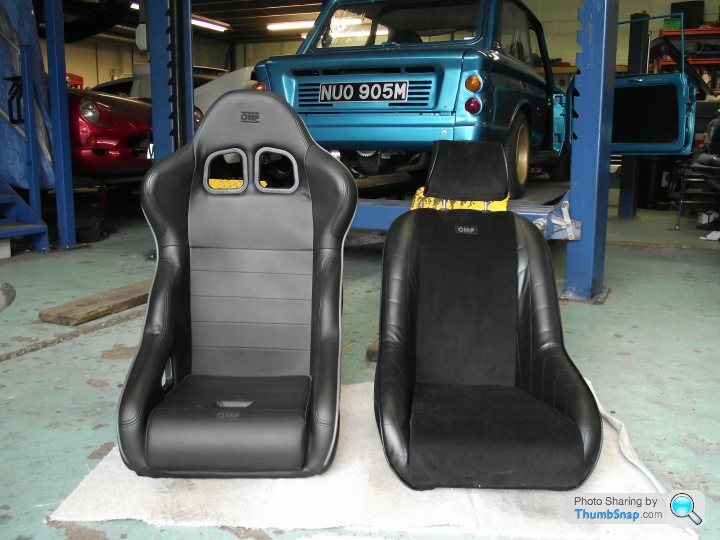
Never really liked the full buckets, in terms of style and in terms of fitment. They were MASSIVE in the little Imp. They'd be great in something a bit bigger, but I wanted a more old school look:
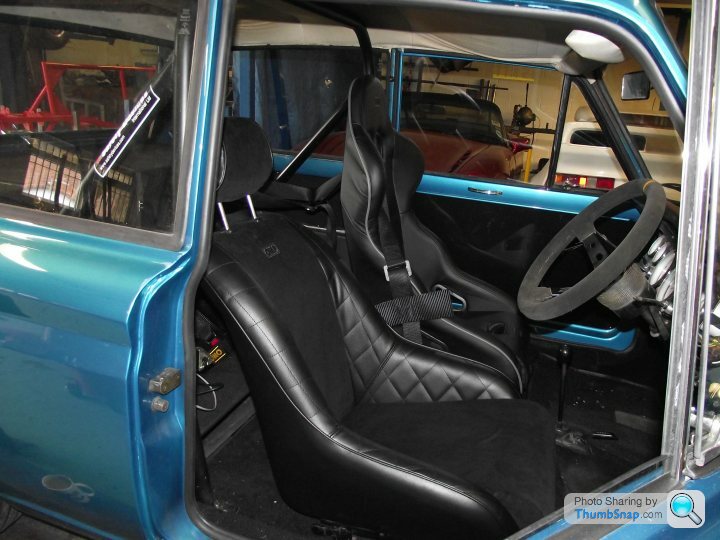
They match the OMP harnesses, and OMP steering wheel. I could be sponsored by OMP!:
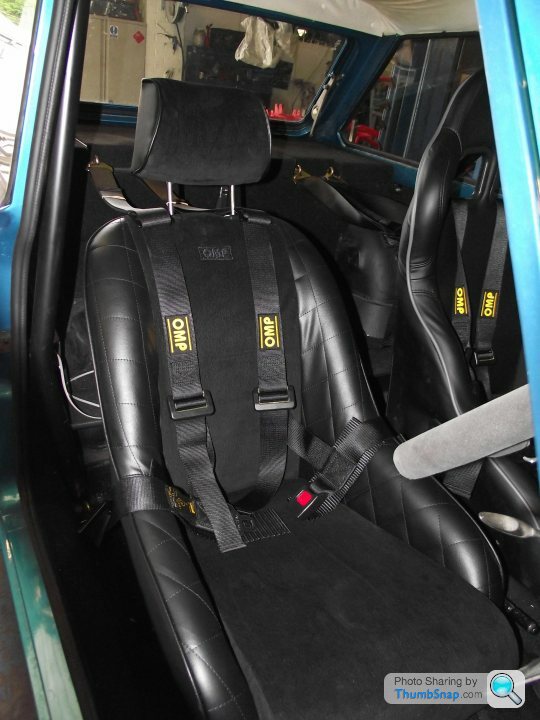
They also have corduroy centres. Win:
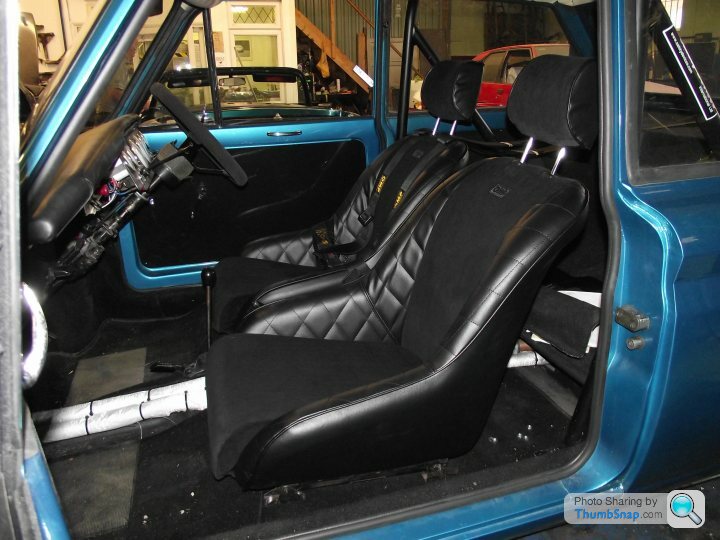
Anybody want to buy a pair of seats? All funds go to a good cause :
:
Moderator edit: no advertising please.
So on to more pressing issues - gearbox.
The transaxle I'm running is the standard Imp transaxle. It's very light (good), very short geared (not so good) and fairly weak (obviously a bummer, but not so much of an issue if you're sensible and don't try to jump from about 45bhp to around 110bhp).
The idea with the conversion was that if it chewed a gearbox up, we could replace the engine with a 1400, 1300 or even 1100cc version of the TU in preparation for the next gearbox. Or, we could upgrade the gearbox, but unless you want to spend £3k on a 5-speed Jack Knight dog-box, that's going to involve cutting and shutting something. Or, Tim (now me) could just learn to drive a bit smoother!
Now, we have transmission issues already, with around 100miles covered. Or rather, I suspect we have clutch issues. The gearbox is dropping oil from the bellhousing area, and when fully depressing the clutch pedal, you hear a nasty grounching kind of noise. Trying to select gear can make this worse, but not by much. It'll do it in neutral. Let go of the clutch, and all is quiet again. Gear selection gets worse the more you drive the car.
So we have a problem! The original Imp setup used a slave cylinder, release arm and normal clutch (first car to have a sprung centre plate I believe - more innovation there, innovation fans!) In order to run the TU, we had to improvise!
We used a modified Imp input shaft, found purely by chance on an Imp forum. It had been made to accept a Ford-spec clutch plate, so that's exactly what we used - a Ford Sierra 1600 clutch plate, turned down around 5mm to mate up to a Saxo 1400 clutch cover (which was designed to use a 180mm clutch, not the 200mm of the standard VTR spec. Because of this, we dropped down to a 1400 flywheel too, which came from a 106 Quiksilver (on the bay of E, at a cost of £10, posted!) We had to drop down to a 180mm clutch as the 200mm one wouldn't fit inside the Imp gearbox bellhousing! So, we sent the shaft away along with the rebuilt Reg Patten gearbox, back to Reg Patten for him to install the new input shaft.
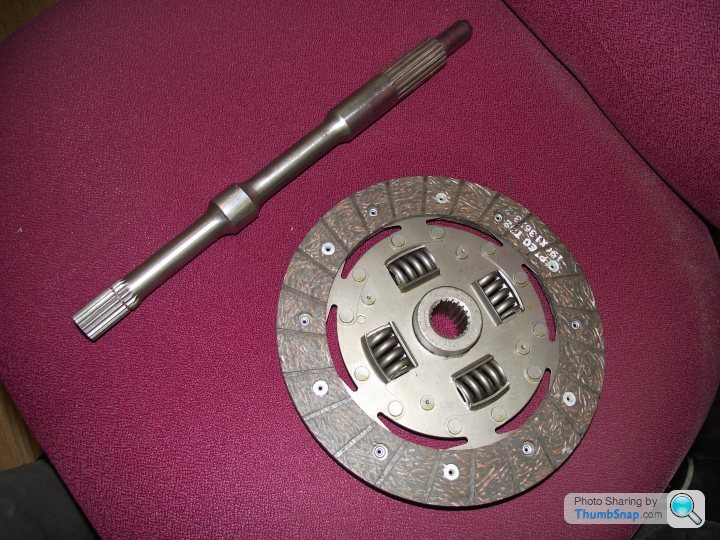
When it came back, we fitted this:
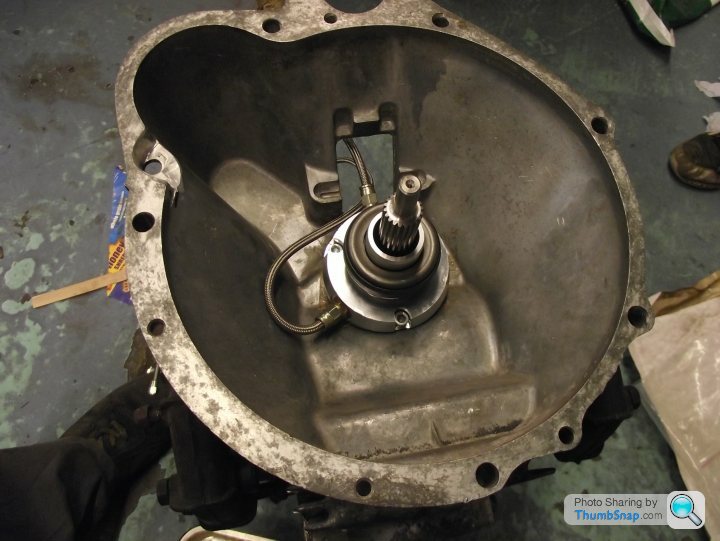
Concentric slave cylinder. At the moment, it's my belief that this is the unit at fault. Why, is anybody's guess. Worst case, the gearbox doesn't like having the load of the clutch against it there, and has fractured (causing the oil leak). Best case scenario, the design is fine and it's simply a faulty unit.
We'll find out tomorrow, when I pull the engine out and have a look!
- I've got suspected fuelling problems with the carbs
- I've got some pretty bad bodywork issues, caused by the guy who did the panelwork on it prior to the paintjob (carried out by a different guy)
- I've got clutch/transmission issues.

Never really liked the full buckets, in terms of style and in terms of fitment. They were MASSIVE in the little Imp. They'd be great in something a bit bigger, but I wanted a more old school look:

They match the OMP harnesses, and OMP steering wheel. I could be sponsored by OMP!:

They also have corduroy centres. Win:

Anybody want to buy a pair of seats? All funds go to a good cause
 :
:Moderator edit: no advertising please.
So on to more pressing issues - gearbox.
The transaxle I'm running is the standard Imp transaxle. It's very light (good), very short geared (not so good) and fairly weak (obviously a bummer, but not so much of an issue if you're sensible and don't try to jump from about 45bhp to around 110bhp).
The idea with the conversion was that if it chewed a gearbox up, we could replace the engine with a 1400, 1300 or even 1100cc version of the TU in preparation for the next gearbox. Or, we could upgrade the gearbox, but unless you want to spend £3k on a 5-speed Jack Knight dog-box, that's going to involve cutting and shutting something. Or, Tim (now me) could just learn to drive a bit smoother!
Now, we have transmission issues already, with around 100miles covered. Or rather, I suspect we have clutch issues. The gearbox is dropping oil from the bellhousing area, and when fully depressing the clutch pedal, you hear a nasty grounching kind of noise. Trying to select gear can make this worse, but not by much. It'll do it in neutral. Let go of the clutch, and all is quiet again. Gear selection gets worse the more you drive the car.
So we have a problem! The original Imp setup used a slave cylinder, release arm and normal clutch (first car to have a sprung centre plate I believe - more innovation there, innovation fans!) In order to run the TU, we had to improvise!
We used a modified Imp input shaft, found purely by chance on an Imp forum. It had been made to accept a Ford-spec clutch plate, so that's exactly what we used - a Ford Sierra 1600 clutch plate, turned down around 5mm to mate up to a Saxo 1400 clutch cover (which was designed to use a 180mm clutch, not the 200mm of the standard VTR spec. Because of this, we dropped down to a 1400 flywheel too, which came from a 106 Quiksilver (on the bay of E, at a cost of £10, posted!) We had to drop down to a 180mm clutch as the 200mm one wouldn't fit inside the Imp gearbox bellhousing! So, we sent the shaft away along with the rebuilt Reg Patten gearbox, back to Reg Patten for him to install the new input shaft.

When it came back, we fitted this:

Concentric slave cylinder. At the moment, it's my belief that this is the unit at fault. Why, is anybody's guess. Worst case, the gearbox doesn't like having the load of the clutch against it there, and has fractured (causing the oil leak). Best case scenario, the design is fine and it's simply a faulty unit.
We'll find out tomorrow, when I pull the engine out and have a look!
Edited by jeremyc on Friday 1st July 08:04
So Friday saw an attempt to figure out what the gearbox issue is. Engine and gearbox to be removed, which begins by access the back of the engine via the interior of the car (aha! Stick that in your hash-pipe Hillman!):
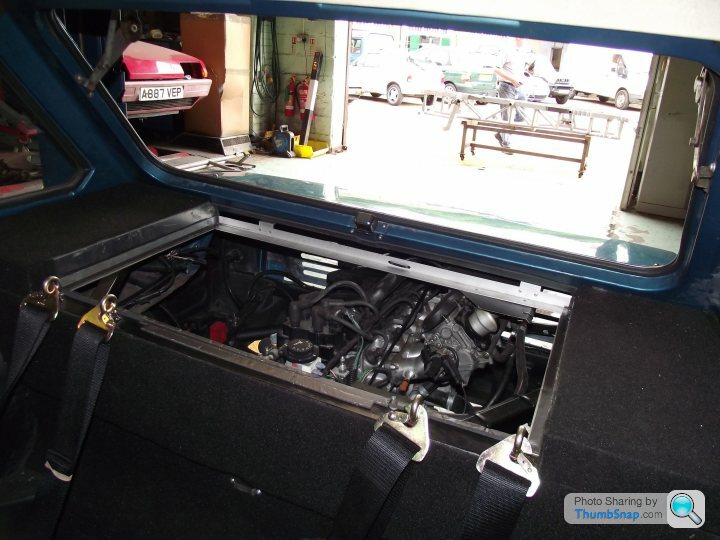
Engine and box out (again):
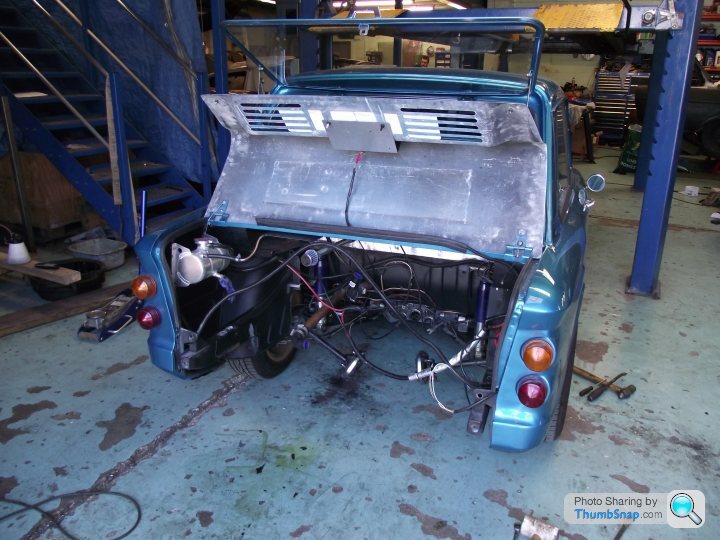
Engine and box split:
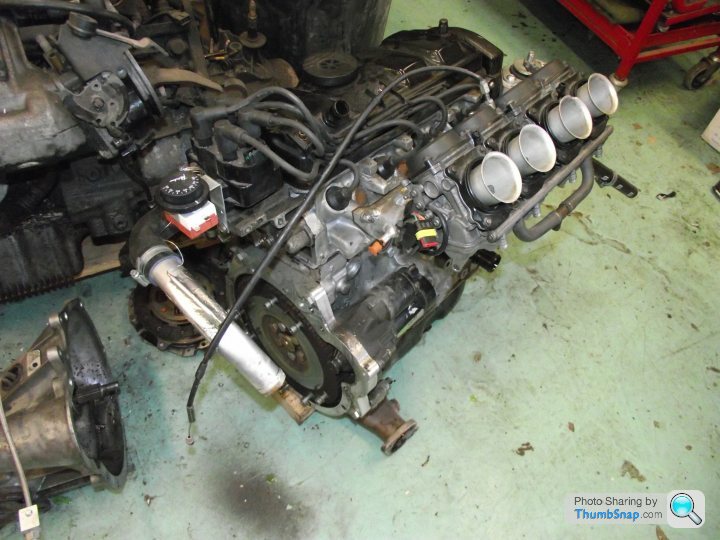
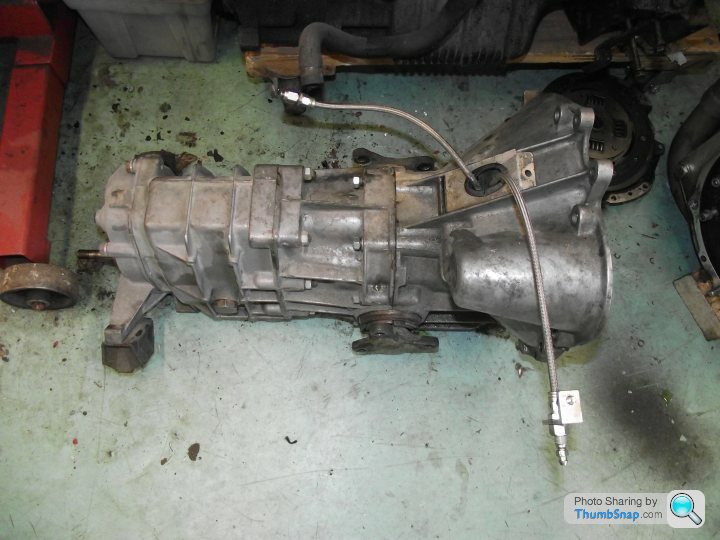
Trying to work through my head as to what could cause the issue. The issue being a loud groaning sound, matched to engine revs, which arises when you press the clutch pedal down. I had visions of the release bearing failing (it has, as it goes - or the bearing part at least) or something grinding away on something else. I didn't stop to consider the thrust bearing, which looked fine on the face of things:
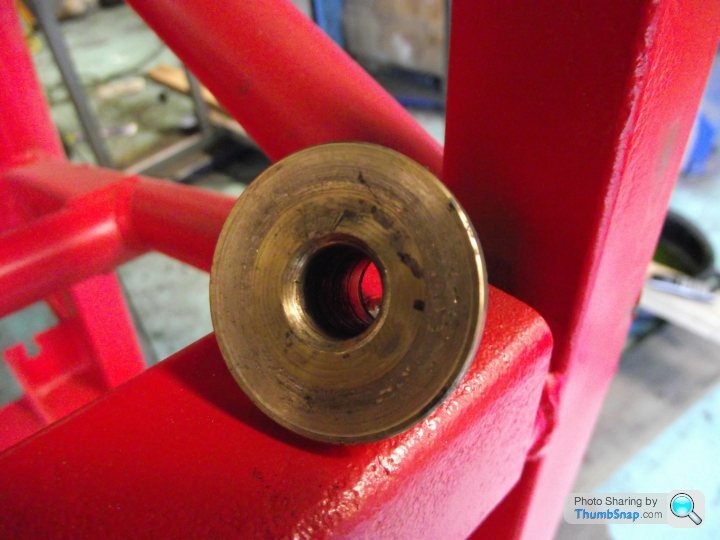
But rattled around in the end of the crank like a prick in a shirt sleeve! This is why:
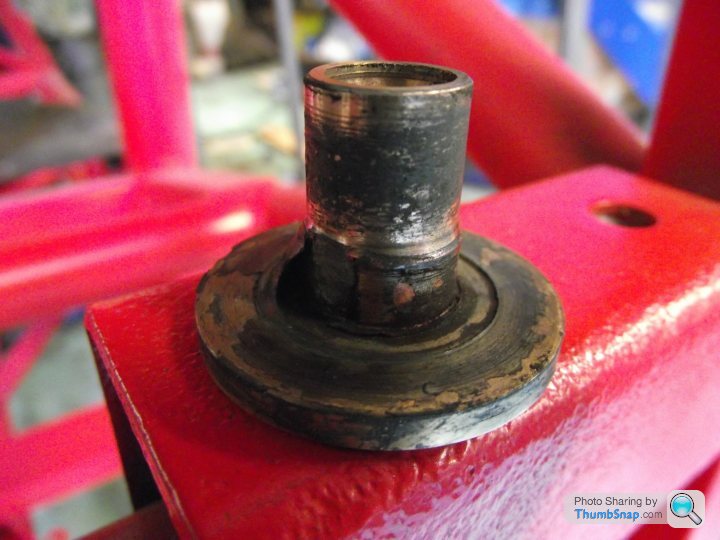
150miles down the line, it's knackered. So why?
Well, the Imp transaxle has a very floppy input shaft (ooh err!) Stood alone, there is no bearing support and the shaft flops around. It's designed to engage at the very end into a bearing at the end of the crankshaft, which a Climax lump used.
The Saxo setup is different. There is no play in the Saxo's input shaft, and they don't use a spigot bearing. Because of this, we had to make one from phosphor-bronze, which we then bonded into the end of the Saxo crank. It looks like the epoxy we used didn't really hold up to the job, so on Monday I'll be popping down to see the boys at the local engineering works and see if they can make me one which is more of an interference-fit. Stick it in a freezer while heating the crank up in preparation, kind of thing.
Fingers crossed, that was the issue with both the noise and with gear selection.

Engine and box out (again):

Engine and box split:


Trying to work through my head as to what could cause the issue. The issue being a loud groaning sound, matched to engine revs, which arises when you press the clutch pedal down. I had visions of the release bearing failing (it has, as it goes - or the bearing part at least) or something grinding away on something else. I didn't stop to consider the thrust bearing, which looked fine on the face of things:

But rattled around in the end of the crank like a prick in a shirt sleeve! This is why:

150miles down the line, it's knackered. So why?
Well, the Imp transaxle has a very floppy input shaft (ooh err!) Stood alone, there is no bearing support and the shaft flops around. It's designed to engage at the very end into a bearing at the end of the crankshaft, which a Climax lump used.
The Saxo setup is different. There is no play in the Saxo's input shaft, and they don't use a spigot bearing. Because of this, we had to make one from phosphor-bronze, which we then bonded into the end of the Saxo crank. It looks like the epoxy we used didn't really hold up to the job, so on Monday I'll be popping down to see the boys at the local engineering works and see if they can make me one which is more of an interference-fit. Stick it in a freezer while heating the crank up in preparation, kind of thing.
Fingers crossed, that was the issue with both the noise and with gear selection.
Just realised I never updated this!
So what's happened so far? Well, I had to go on a speeding awareness course, as the trip to the Seven Stars with the wife resulted in being zapped by a man in a van! Speedo wasn't working - it's a fair cop!
Since then I've removed the engine, installed the new spigot bush, refitted the engine etc and made a few tweaks to the layout. Horrible noise coming from spigot bush gone, but now the clutch is not working properly, and I have a torrent of DOT5.1 hitting the floor. Time to drop the concentric cylinder and explore other ideas.
I've also sourced an original mk2/3 dashboard, as I'm not really loving the non-dash the car currently has. Plans are to get a mate to flock it, tart it up with some carbon fibre and tit bits and go from there. I want to keep the electromagnetic indicator stalks though - they rock.
It also needs some bodywork to sort out the mess the first bodyshop guy made of the doors, but I suspect this might have to wait for a while.
Oh, and the wheels are no longer gold:
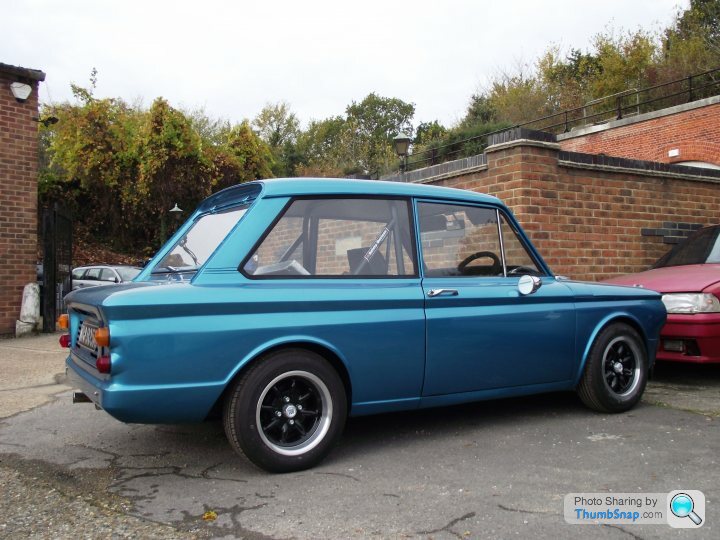
So what's happened so far? Well, I had to go on a speeding awareness course, as the trip to the Seven Stars with the wife resulted in being zapped by a man in a van! Speedo wasn't working - it's a fair cop!
Since then I've removed the engine, installed the new spigot bush, refitted the engine etc and made a few tweaks to the layout. Horrible noise coming from spigot bush gone, but now the clutch is not working properly, and I have a torrent of DOT5.1 hitting the floor. Time to drop the concentric cylinder and explore other ideas.
I've also sourced an original mk2/3 dashboard, as I'm not really loving the non-dash the car currently has. Plans are to get a mate to flock it, tart it up with some carbon fibre and tit bits and go from there. I want to keep the electromagnetic indicator stalks though - they rock.
It also needs some bodywork to sort out the mess the first bodyshop guy made of the doors, but I suspect this might have to wait for a while.
Oh, and the wheels are no longer gold:

Time for an Impdate!
Work has resumed on the Imp, mostly because it's immobile and in the way, and I need to get it out and home again. If that means fixing it so it can be driven and enjoyed again, so be it!
The main issues currently concerning the Imp are:
1) The clutch, which didn't work and needed a re-think
2) The interior, which I wasn't mad on, and needed a rethink
3) The bodywork, which needs sorting!
Of those three, the bodywork is the least important. It won't be done any time soon, mostly because funds don't currently allow. The issues aren't the paint, as on the whole it's a beautiful paint job. It was done by a mate of mine, though if he spots the bit he didn't quite cover properly under the driver's door on the sill, he'll kick himself!
It'll be sorted when the bigger bodywork issues are sorted, namely the fact the panel gaps around the doors are atrocious! They were done by a bodyshop on my workshop's industrial estate, and they are shocking! I shouldn't be surprised, as I've had similar issues on another car I had done there. Still, you live and learn!
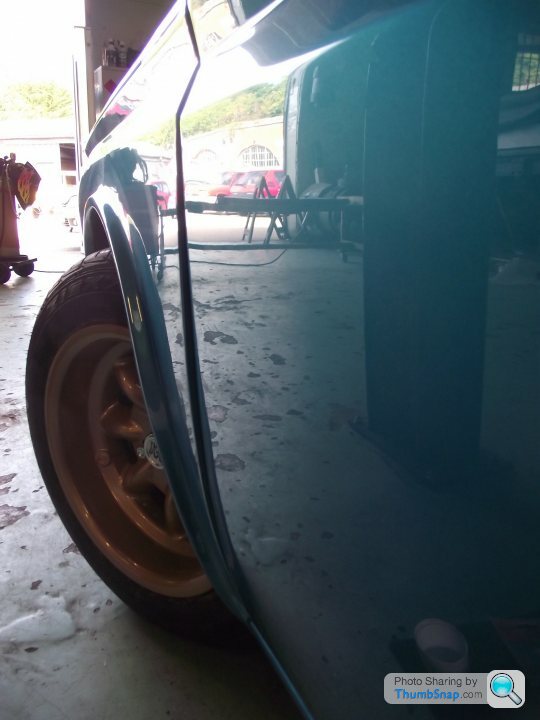
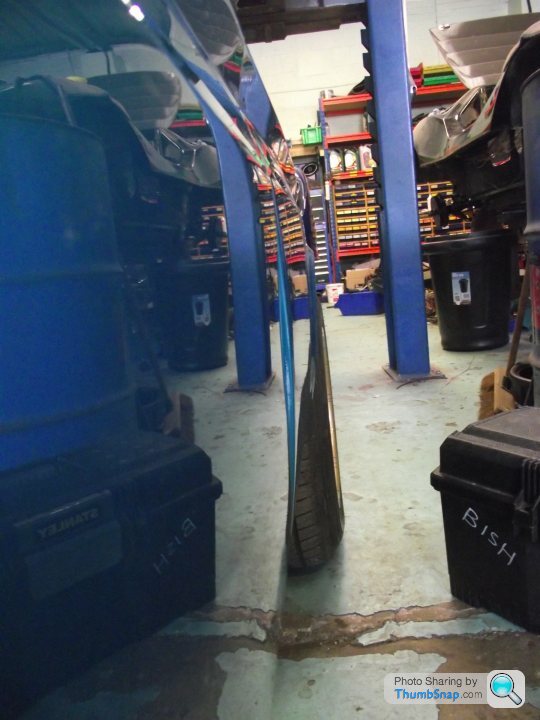
I also found that he'd used a fair bit of filler in the front arches, when the front tyre tried to knaw a chunk off:
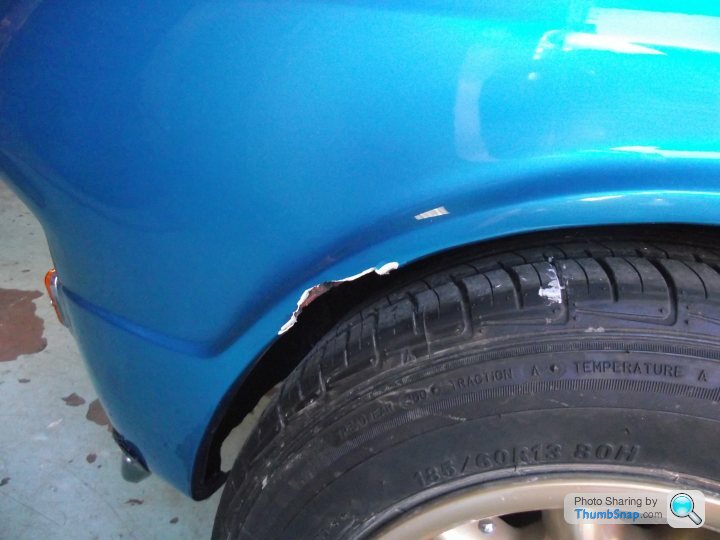
Anyway, as I say the bodywork will have to wait. What's more important is getting it to drive right! The interior will come later.
Those who've been following the thread will remember I've had issues with the concentric slave cylinder arrangement we first used. The setup had its advantages, as the bearing had its own guide so to speak. It exerted the force directly onto the clutch, with no other moving parts. Great!
Only not. The issue has been getting the thing to stay leak-free. The unions had leaked since day one, and once I'd finally got those to seal, the main seals themselves decided to start weeping. It could probably be fixed and used again, but I've given up on it. The main problem is that each time you want to do anything with it, you have to take the bloody engine out and take the gearbox off! It's not that hard, but after the 3rd time it gets pretty boring!
Originally, the Imp used a hydraulic setup, with a slave cylinder pushing on a release arm posted in from the top of the bellhousing, thus:
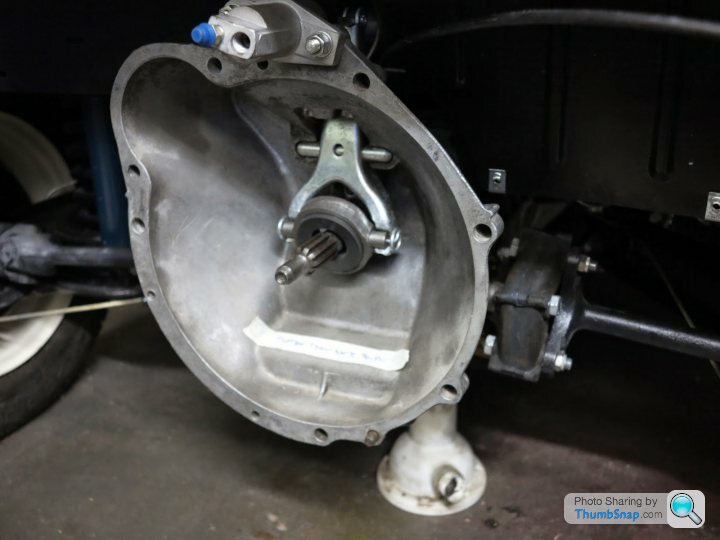
I decided that I would go back to this tried and tested layout, but realised there was a problem fairly early on; The original Imp engine is canted over, and the Saxo engine sits bolt-upright. This means that there is an engine where the Imp slave cylinder needs to go. Bum.
I looked into 'pull'-type cylinders, that I could mount on the opposite site of the release arm. I looked at making a cradle for the standard cylinder to sit inside, in front of the release arm (so that when extended, with would drag the arm in the right direction). However, salvation was at hand, in the form of Car Builder Solutions! They offered a very slim clutch slave cylinder:
{url]http://www.carbuildersolutions.com/uk/flat-backed-clutch-slave-cylinder[/url]
With one of these, I might be on to something! I ordered one up, adjusted it so it fitted and offered it up. it fitted! The only issue was that the cylinder sat slightly higher, which then meant I had to cut the top off the release arm I'd found, and attempt to extend it:
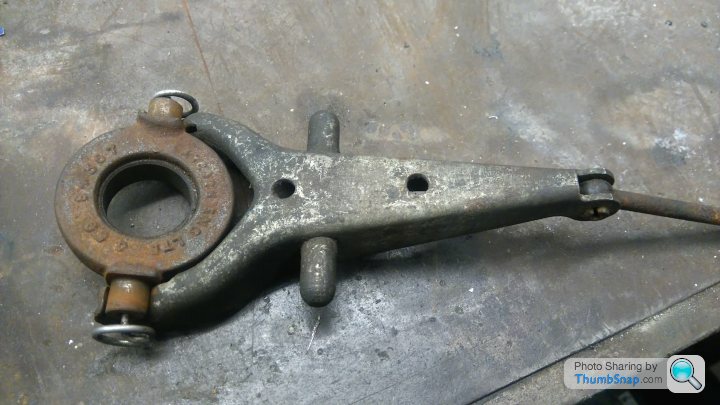
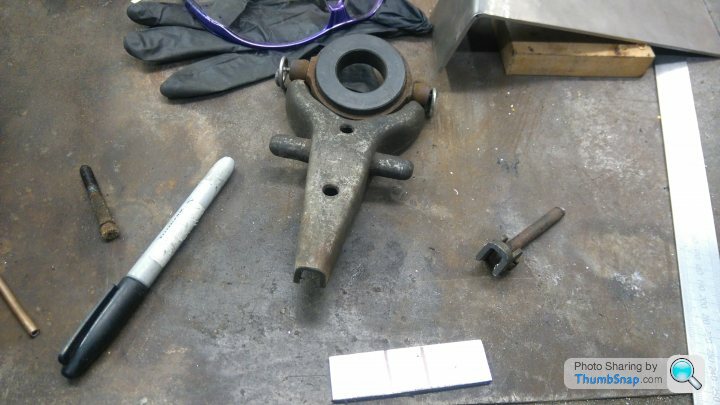
Once I'd extended it up to the height required to meet the cylinder, it was looking promising!
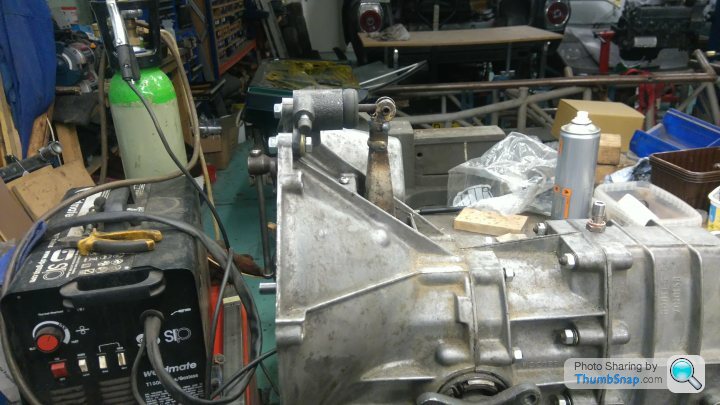
That was the top taken care of (and yes, I've done some maths and it will extend far enough to disengage the clutch - I even measured how much travel was needed to do this:
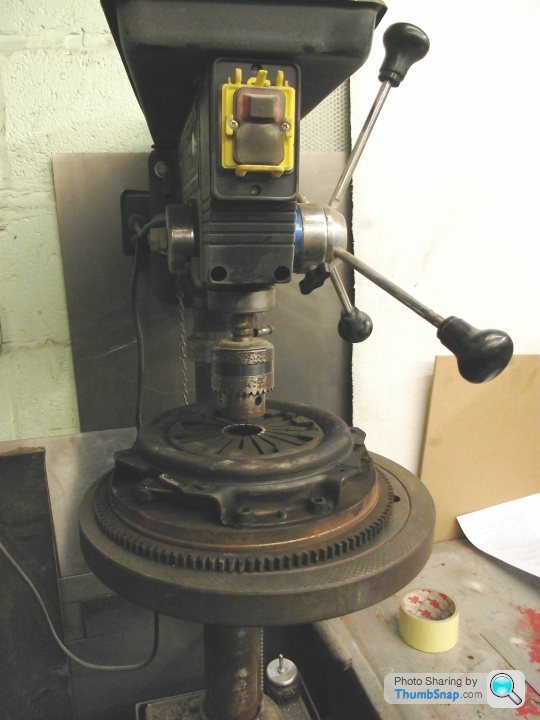
I even filmed it in action! Only needs about 5.5mm of movement from the would-be release bearing to completely disengage:
https://youtu.be/DqXUdgtYQhw
The original Imp setup, however, used one of those 'orrible graphite bush-type affairs, rather than an actual bearing. Aside from being awful, this is incompatible with the clutch cover, being a TU 1.4 setup.
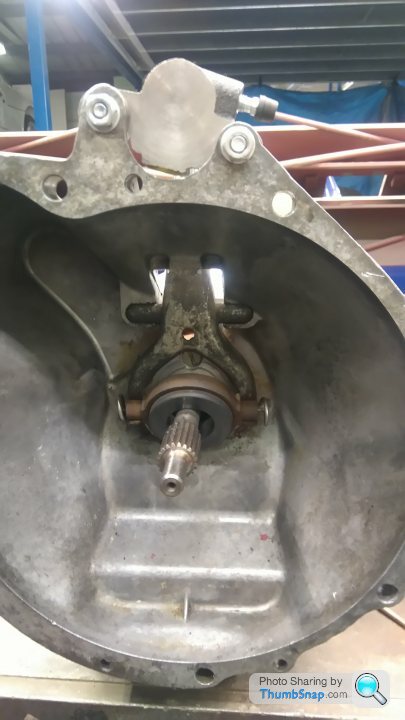
So I set about trying to remove the carbon/grahpite bush from the Imp's release mech so I could attempt to convert it to a bearing-type setup......and broke it.
I have no pictures of this. Honest!
I wasn't 100% sure that this was the best way to go, as there would be more work to be done trying to extend the release mech out to reach the clutch (baring in mind the adapter plate between the engine and gearbox means everything has be extended forwards the same kind of distance), but with no other ideas immediately at hand, I decided to get another bearing in to see where I'd end up. I had a stroke of luck, as by chance I discovered MG Midgets (with the A-series lump) use a similar setup, only slightly deeper:
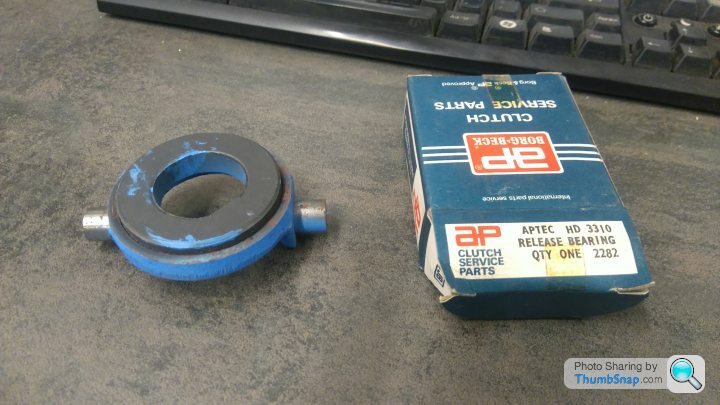
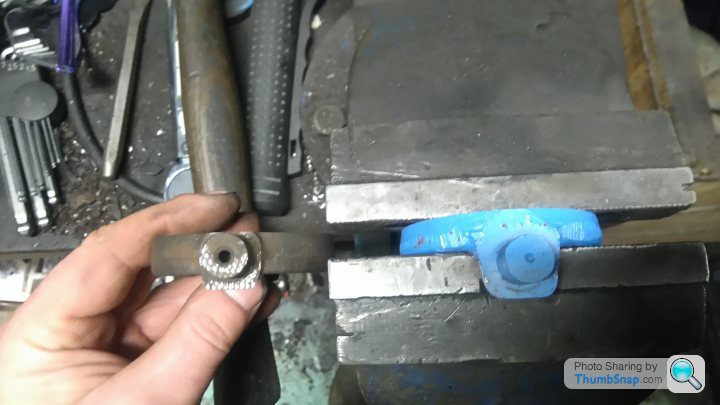
I drilled the retaining clip holes and successfully removed the graphite from the housing:
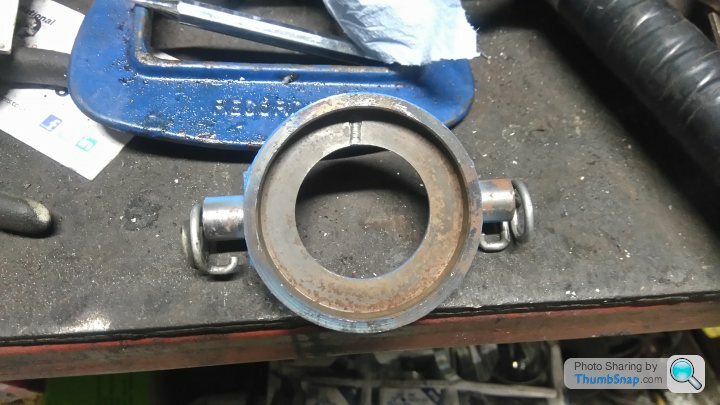
It now fits the Imp release arm:
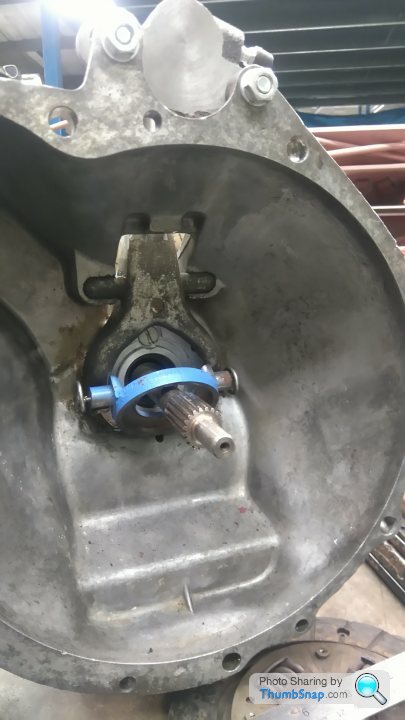
It hasn't won me all the extra clearance I needed to make up for the adapter plate, but it's a step towards it. However, I'm now at another crossroads. You can see in that pic above that the release housing is drooped over - the centre of gravity just can't keep it upright, even with the standard Imp bearing.
The issue is that once the clutch is fitted and everything's in place, the top of the bearing is going to constantly be resting against the clutch fingers. Now there won't be much weight against it (not unless I use the clutch as a footrest like a numpty), so in theory the bearing should be OK. To be fair, even if it did shorten the life of it to something like 15,000 miles, how long exactly is it going to take this car to do 15,000 miles?! It'll be 15years I expect!
Even so, it bugs me. I like the idea of using a sleeve for the bearing to slide up and down, like on the original Saxo setup, but the problem is the release arm has fixed location points to the bearing; It won't allow it to move back and forth as it's trying to move in a small arc, and when sliding up and down a sleeve there is no room for an arc, with or without all the animals and floods and Noah and s t.
t.
So my thought processes at the moment are:
Work has resumed on the Imp, mostly because it's immobile and in the way, and I need to get it out and home again. If that means fixing it so it can be driven and enjoyed again, so be it!
The main issues currently concerning the Imp are:
1) The clutch, which didn't work and needed a re-think
2) The interior, which I wasn't mad on, and needed a rethink
3) The bodywork, which needs sorting!
Of those three, the bodywork is the least important. It won't be done any time soon, mostly because funds don't currently allow. The issues aren't the paint, as on the whole it's a beautiful paint job. It was done by a mate of mine, though if he spots the bit he didn't quite cover properly under the driver's door on the sill, he'll kick himself!
It'll be sorted when the bigger bodywork issues are sorted, namely the fact the panel gaps around the doors are atrocious! They were done by a bodyshop on my workshop's industrial estate, and they are shocking! I shouldn't be surprised, as I've had similar issues on another car I had done there. Still, you live and learn!


I also found that he'd used a fair bit of filler in the front arches, when the front tyre tried to knaw a chunk off:

Anyway, as I say the bodywork will have to wait. What's more important is getting it to drive right! The interior will come later.
Those who've been following the thread will remember I've had issues with the concentric slave cylinder arrangement we first used. The setup had its advantages, as the bearing had its own guide so to speak. It exerted the force directly onto the clutch, with no other moving parts. Great!
Only not. The issue has been getting the thing to stay leak-free. The unions had leaked since day one, and once I'd finally got those to seal, the main seals themselves decided to start weeping. It could probably be fixed and used again, but I've given up on it. The main problem is that each time you want to do anything with it, you have to take the bloody engine out and take the gearbox off! It's not that hard, but after the 3rd time it gets pretty boring!
Originally, the Imp used a hydraulic setup, with a slave cylinder pushing on a release arm posted in from the top of the bellhousing, thus:

I decided that I would go back to this tried and tested layout, but realised there was a problem fairly early on; The original Imp engine is canted over, and the Saxo engine sits bolt-upright. This means that there is an engine where the Imp slave cylinder needs to go. Bum.
I looked into 'pull'-type cylinders, that I could mount on the opposite site of the release arm. I looked at making a cradle for the standard cylinder to sit inside, in front of the release arm (so that when extended, with would drag the arm in the right direction). However, salvation was at hand, in the form of Car Builder Solutions! They offered a very slim clutch slave cylinder:
{url]http://www.carbuildersolutions.com/uk/flat-backed-clutch-slave-cylinder[/url]
With one of these, I might be on to something! I ordered one up, adjusted it so it fitted and offered it up. it fitted! The only issue was that the cylinder sat slightly higher, which then meant I had to cut the top off the release arm I'd found, and attempt to extend it:


Once I'd extended it up to the height required to meet the cylinder, it was looking promising!

That was the top taken care of (and yes, I've done some maths and it will extend far enough to disengage the clutch - I even measured how much travel was needed to do this:

I even filmed it in action! Only needs about 5.5mm of movement from the would-be release bearing to completely disengage:
https://youtu.be/DqXUdgtYQhw
The original Imp setup, however, used one of those 'orrible graphite bush-type affairs, rather than an actual bearing. Aside from being awful, this is incompatible with the clutch cover, being a TU 1.4 setup.

So I set about trying to remove the carbon/grahpite bush from the Imp's release mech so I could attempt to convert it to a bearing-type setup......and broke it.
I have no pictures of this. Honest!
I wasn't 100% sure that this was the best way to go, as there would be more work to be done trying to extend the release mech out to reach the clutch (baring in mind the adapter plate between the engine and gearbox means everything has be extended forwards the same kind of distance), but with no other ideas immediately at hand, I decided to get another bearing in to see where I'd end up. I had a stroke of luck, as by chance I discovered MG Midgets (with the A-series lump) use a similar setup, only slightly deeper:


I drilled the retaining clip holes and successfully removed the graphite from the housing:

It now fits the Imp release arm:

It hasn't won me all the extra clearance I needed to make up for the adapter plate, but it's a step towards it. However, I'm now at another crossroads. You can see in that pic above that the release housing is drooped over - the centre of gravity just can't keep it upright, even with the standard Imp bearing.
The issue is that once the clutch is fitted and everything's in place, the top of the bearing is going to constantly be resting against the clutch fingers. Now there won't be much weight against it (not unless I use the clutch as a footrest like a numpty), so in theory the bearing should be OK. To be fair, even if it did shorten the life of it to something like 15,000 miles, how long exactly is it going to take this car to do 15,000 miles?! It'll be 15years I expect!
Even so, it bugs me. I like the idea of using a sleeve for the bearing to slide up and down, like on the original Saxo setup, but the problem is the release arm has fixed location points to the bearing; It won't allow it to move back and forth as it's trying to move in a small arc, and when sliding up and down a sleeve there is no room for an arc, with or without all the animals and floods and Noah and s
 t.
t.So my thought processes at the moment are:
- Do I need to fit a sleeve, and in doing so have to redesign the release bearing setup and how the arm operates it.......again
- Can I just have a spacer made to go between the existing release housing and the current release bearing, and live with the arch it sweeps in an arc?
davepoth said:
What about putting a "bump stop" inside the bellhousing so that when the arm is in the disengaged position it prods the housing from the back and forces it to be vertical?
I did wonder about something like that this evening. Just something for it to park against when the pedal's off. I'm planning to fit a return spring to the release arm, so it might work well with that.AyBee said:
davepoth said:
What about putting a "bump stop" inside the bellhousing so that when the arm is in the disengaged position it prods the housing from the back and forces it to be vertical?
I like this idea - was also going to suggest adding weight to the bottom to change its centre of gravity.So then the idea of using a spring instead of a fixed bump stop was used, but we couldn't find a way to get the spring to sit squarely. Also, the spring would push the bearing into the clutch and cause the release bearing to be permanently engaged - something it's not designed to do.
So we went back to just having the bearing hanging there. Worst case scenario is that the release bearing chatters a bit on idle, but in fairness I don't think you'd hear it

Funnily enough, adding weight and changing the COG would have been the best way to go about things, but it's difficult to achieve it, especially given the engine has to go back in and be running to know how successful you are or not!
TimmyJK7 said:
Great write up Rich! It is still very upsetting to not owning this but I know it is in the best of hands. I cannot wait for this car to be finally finished and being enjoyed on the roads! Good luck Rich!
Cheers Tim. Fair to say the car wouldn't be here today if it weren't for you.NiceCupOfTea said:
I love this. My dad had 2 Imps in the early 80s, a bog standard one and an Imp Sport (Stiletto engine), lovely things. I can still feel the hot vinyl seats on my legs in the summer and remember the clang of the doors 
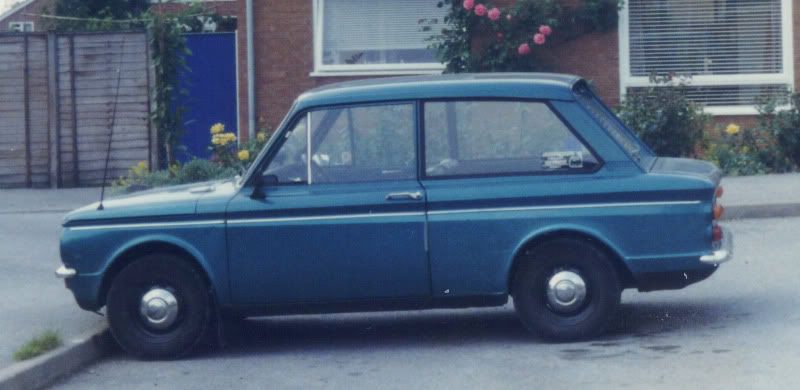

Can't tell from the pics, but one of them is pretty much the same colour as yours!
Top one looks pretty similar. It's probably what this one looked like, originally! No vinyl under the thighs now - these seats have corduroy!


Can't tell from the pics, but one of them is pretty much the same colour as yours!
rallycross said:
I have seen this car and I love it but I cant help think that heavy lump from the Saxo should not be in there!
The original car had the lightest of engines, alloy, compact, light, just like an AX GT engine - if anyone can do it you can Rich, a lightly tuned Tu3-S on twin 40's would be ideal!
At the time the car was built, the VTR lump was the easiest to obtain (just buy a car!) and it would run 100bhp all day long. Also, the research I'd carried out suggested it wasn't much heavier than the alloy lumps, but having weighed everything it turns out it's 40kg more, or half of a me. Obviously lots of weight has been lost over the back end too, what with the carbon lid, radiator/battery etc. moving up front. Won't know the full extent until it goes on a weighbridge (which it will, one day).The original car had the lightest of engines, alloy, compact, light, just like an AX GT engine - if anyone can do it you can Rich, a lightly tuned Tu3-S on twin 40's would be ideal!
My plan here is to get some decent miles on it, get a feel for it, throw it around and see what I think. I haven't driven it much, but on all the times I did before, I actually thought it handled nicely.
If, further down the road I decide that there is too much weight over the rear end, I have an AX GT engine sat here that I can rebuild, tune up a bit and fit. The clutch, exhaust, carbs, cooling pipes etc will all fit, but the gearbox adapter plate won't, as the PCD is different on an early alloy TU. So I'd either have to get another adapter plate made, or modify this one. But it wouldn't be too difficult, and the alloy TU is almost identical in weight to the original Climax-based Imp engine (about 3kg heavier).
rev-erend said:
Another idea is a motorbike engine like a Huyabuasa or similar..
A mate has one in the back of his Mini cooper .. space framed the lot.
Motorbike engine was thrown out at the beginning (superbike ones, anyway). They're horrible to drive in cars, as the lack of torque means you have to rev the arse off them so you don't stall them. Amazing on a track, but a PITA on the road. The BMW K-Series idea wasn't around too much back when we did this, but that's one I'd give more serious thought to now.A mate has one in the back of his Mini cooper .. space framed the lot.
Spaceframe-wise, again we didn't want to do it. Firstly you get problems with IVA etc (as a professional outfit it has to be legit, and to be honest I see it as part of the challenge to act within the rules) and secondly it wouldn't be an Imp anymore. We could have cut the front off a Focus ST and stuck that in the back of the Imp, but wouldn't be an Imp anymore. This still is (for better or worse), it just has a different engine.
DocJock said:
There's a fella on RetroRides who does conversions with the BMW K1200 engine as it has the correct rotation to work in a rear-engined installation.
Up to 185bhp (or 250 with turbo kit).
Most engines have the correct rotation to work at the back, it just depends how you feed the power to the wheels. The gearbox on an Imp lump isn't up to 130bhp, let alone 250. I think most Imp guys running the BMW lump are at about 90-110bhp. I would have given it serious consideration as a suggestion to Tim if I'd know about it back then.Up to 185bhp (or 250 with turbo kit).
Evangelion said:
I once had an Imp which was fitted with an 1100 engine from an Escort. I wanted a 1300 and bought it unseen from a scrapyard; on finding it was an 1100 I decided to fit it anyway. (I say 'I', this is a sort of royal we because i didn't touch the thing, someone else was doing it for me.
The adapter plate came, I believe from Jack Knight. The engine was mounted using a Corsair crossmember thus reducing the rear panel to mere decoration. The Ford clutch was cable-actuated, so the linkage had to be modified. The back seat and part of the underlying metalwork had to be removed to make room for the engine as the Ford lump was vertical, whereas the original was canted over at 45 degrees. The front-mounted radiator was from, I believe, a Fiat 124, and finally larger 13-inch wheels were fitted at the rear to raise the gearing.
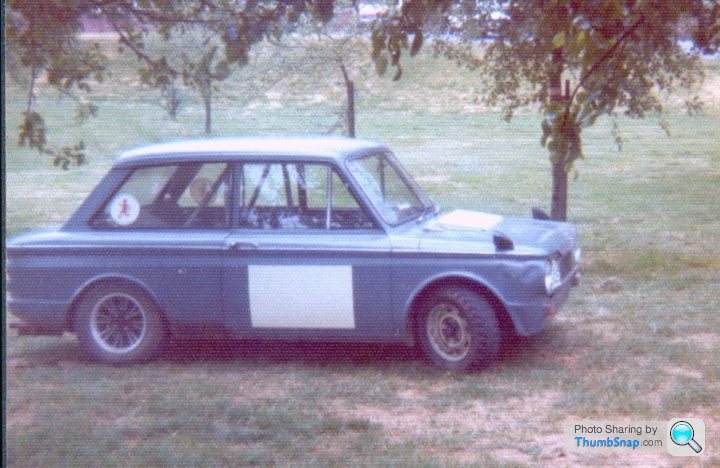
The clutch would frequently slip out of adjustment and become unusable, the treatment being to stop, jump out, open the bonnet (boot?) and give the adjusting nut a turn or two before being able to move off again. In the end, adding a locknut cured that. The long pipework to the radiator meant bleeding the system was fun too, you had to face the car uphill to bring the radiator to the highest point.
Unfortunately the car ate gearboxes at a terrible rate. They tend to flex if too much torque is put through them, which lets the oil out the gaps. It also kept popping driveshaft doughnuts but eventually we found some special racing ones which lasted longer than most. And if you looked at the driveshafts themselves (which were the thicker ones from the Commer Imp van, 1 inch thick instead of 7/8ths) you could see they were twisting because the seams were no longer straight.
It was a little overgeared for an 1100 so performance was less sprightly than it could have been, a 1300 would have been ideal.
The previous owner, who had done the conversion, had used it for grass track racing, with a Lotus Twin-Cam fitted. He claimed to have beaten Win Percy's Datsun 240Z with it.
This was in 1975; I'd had two other Imps before this, the first was a standard 875.
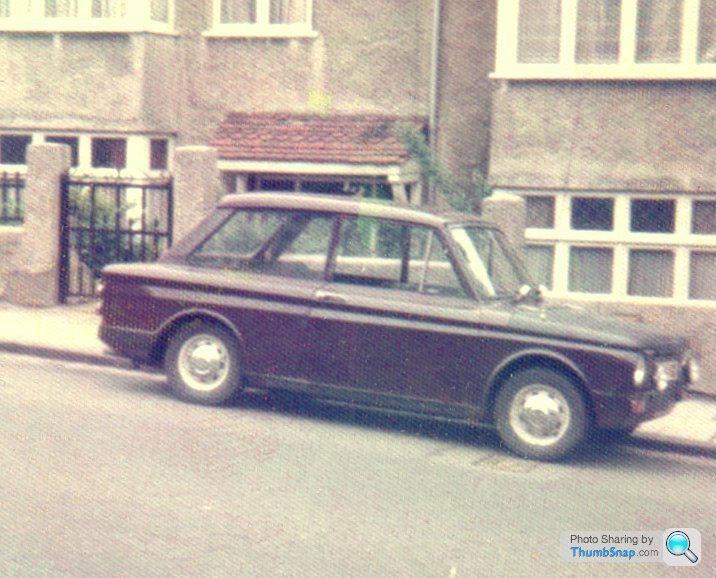
The second had a 998 but the photo was taken before it was fitted which is why its tail is in the air.
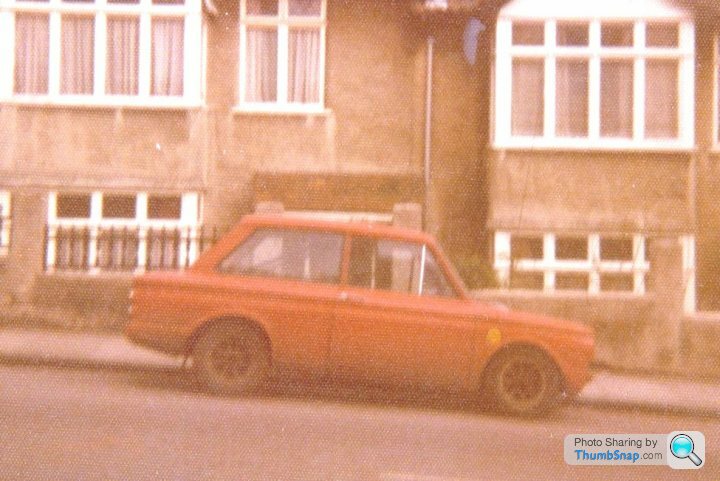
That's really interesting, thanks! And there's me thinking a Saxo engine might be too heavy....... The adapter plate came, I believe from Jack Knight. The engine was mounted using a Corsair crossmember thus reducing the rear panel to mere decoration. The Ford clutch was cable-actuated, so the linkage had to be modified. The back seat and part of the underlying metalwork had to be removed to make room for the engine as the Ford lump was vertical, whereas the original was canted over at 45 degrees. The front-mounted radiator was from, I believe, a Fiat 124, and finally larger 13-inch wheels were fitted at the rear to raise the gearing.

The clutch would frequently slip out of adjustment and become unusable, the treatment being to stop, jump out, open the bonnet (boot?) and give the adjusting nut a turn or two before being able to move off again. In the end, adding a locknut cured that. The long pipework to the radiator meant bleeding the system was fun too, you had to face the car uphill to bring the radiator to the highest point.
Unfortunately the car ate gearboxes at a terrible rate. They tend to flex if too much torque is put through them, which lets the oil out the gaps. It also kept popping driveshaft doughnuts but eventually we found some special racing ones which lasted longer than most. And if you looked at the driveshafts themselves (which were the thicker ones from the Commer Imp van, 1 inch thick instead of 7/8ths) you could see they were twisting because the seams were no longer straight.
It was a little overgeared for an 1100 so performance was less sprightly than it could have been, a 1300 would have been ideal.
The previous owner, who had done the conversion, had used it for grass track racing, with a Lotus Twin-Cam fitted. He claimed to have beaten Win Percy's Datsun 240Z with it.
This was in 1975; I'd had two other Imps before this, the first was a standard 875.

The second had a 998 but the photo was taken before it was fitted which is why its tail is in the air.


The Saxo lump needs no crossmember, as the mounting points are still 'outside' the engine, though we did brace the rear crossmember a fair bit as I had a feeling the Saxo lump might wriggle around a bit more than the Imp one! Same vertical issues with the TU engine though...no parcel shelf anymore, and, realistically speaking, no back seat. That one's a bit of a bummer, I would have liked to have retained some kind of seating arrangement there, but it's not a big deal.
Bleeding the cooling system in on this one's a bit fun too, though it does self-bleed to an extent at the back end. It's only the front end that needs the bleed point, but it takes a lot of coolant! I think it's about 9 litres!
I'm nervy about the gearbox myself. I've gone from 45lbft or so, to 110lb ft, and unlike the tuned Imp engines (or bike engines) the torque is delivered in the midrange. It's very much undergeared, but then it'll pull like a train in 2nd, 3rd or 4th. The speeds are low, and the smiles are big! And it gets there pretty swiftly! I know if there are any full-bore starts the gearbox will pop. It's not a car to just get in and rag around, but then I would never really drive it like that anyway.
It's got the Elan rubber couplings (though I'm keen to upgrade to proper UJs) and it's already running the Imp Sport/Van driveshafts.
Made a bit of progress now, so update coming shortly....
Many nights have passed since I last updated the thread, and that's because many nights have passed since I last did anything to the Imp!
However, progress has, at last, been made! So to pick up where we left off, I had decided to use an original Imp release arm (modified) and mount a slave cylinder externally, as per the original Imp design. I had space issues as the original Imp cylinder lay over the original Imp engine, and because I don't have an original Imp engine, I don't have anywhere for the original Imp slave cylinder to lay. There's a lump of iron where that would go, so a slimline clutch slave cylinder was obtained and fitted.
Initially, we'd been running with a solid spigot bearing (an oilite bush, if we're being pedantic). The first one that went in was awful - too small, and it broke out. The second one that went in last year ended up being too tight on the end of the shaft. Different ideas were floated, before we actually found a supplier of needle-roller bearings in various sizes. The TU engine doesn't use a spigot bearing, as the MA gearbox a Saxo is normally fitted with has the support bearing on the input shaft, but happily there was still a bore hole in the end of the crank, and into that I managed to fit two very lightly greased needle roller bearings:
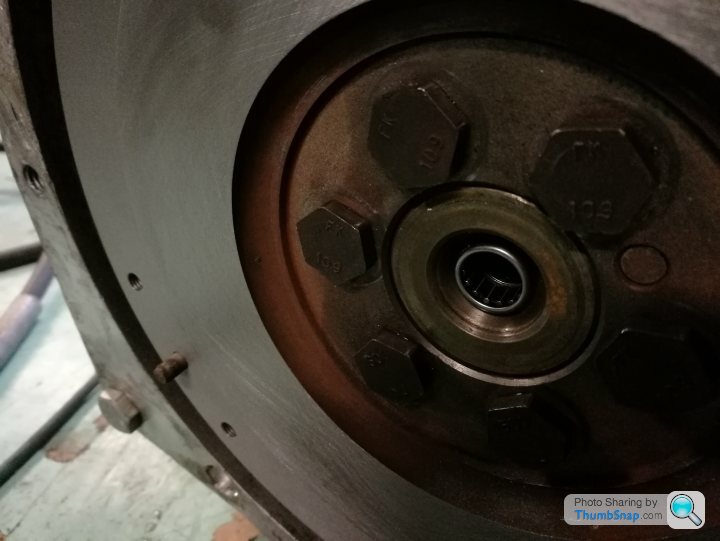
Another modification made through the process was shaving 0.5kg off the flywheel, by using an AX GT item, rather than the 106 Quiksilver item that was already fitted (the original Saxo VTR setup didn't fit in the bell-housing as it used a bigger clutch). I think the half a kilo saving is purely down to the fact the 106 unit had an enlarged timing ring on the outside of it, presumably for the TDC sensor on an injected engine. This change also necessitated the use of an AX GT clutch cover, rather than the 106 one, but that was fine as I had beaten ten bells of s t out of the 106 one trying to remove the gearbox a week or so before!
t out of the 106 one trying to remove the gearbox a week or so before!
The AX GT flywheel was refaced, checked for balance and fitted to the VTR engine:
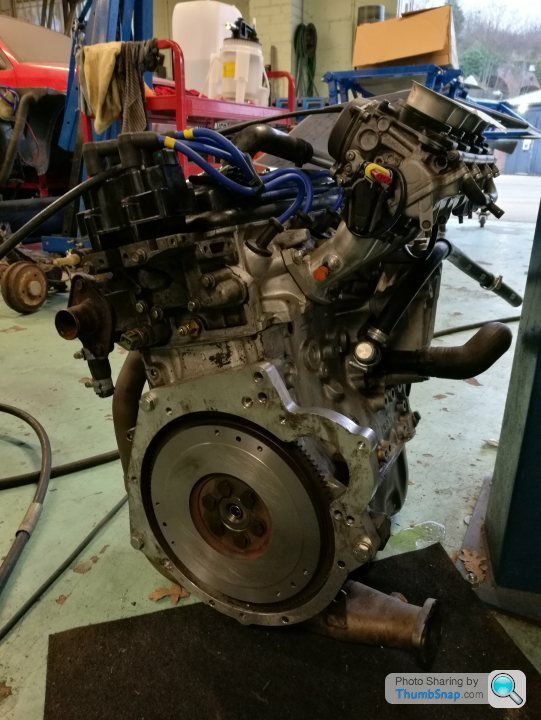
The issue with all this was that I was going to have to space out the release bearing from the housing, which itself just pivoted on the end of the release arm. In a normal Imp, the issue of balance wasn't....well, an issue at all, seeing as the COG of the housing was spot on, and the bearing was actually a carbon bush.
Different ideas were floated around on ways to extend the reach of the bearing (because of the thickness of the adapter, and it causing the gearbox to sit further away from the engine), but without having the issue of the whole assembly tipping over and getting too up close and personal with the clutch cover fingers. That would be a fairly annoying noise!
Eventually, through researching bits on eBay and playing on Google, I arrived at something I thought might work. First step was to obtain an MG Midget (1.3.......I think) release bearing, as seen further above. I then had my business partner turn up a delryn insert, that would fit inside the bearing housing (having removed the carbon bush). I have no decent pics of this, but in this image I'm drilling a tapping it, so that I can fit some small retaining bolts from behind (all they'll do is keep it up against the housing, and stop it trying to rotate in the housing, should the bearing seize up or something:
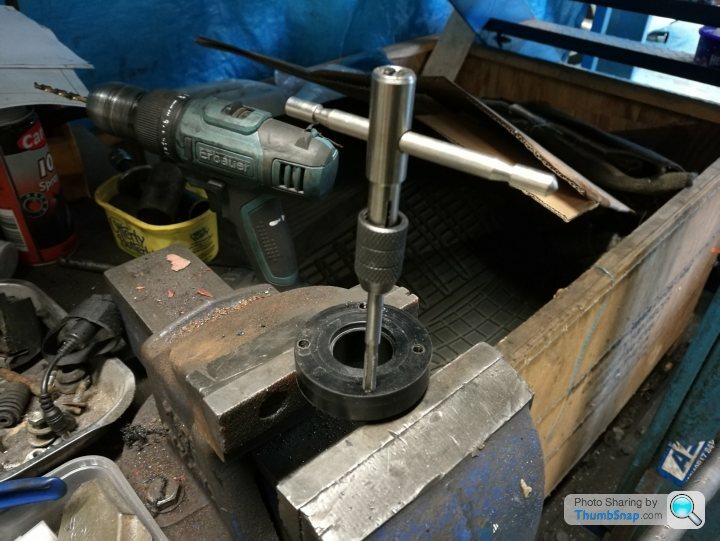
Here it is with the bolts fitted. I'd love to tell you they're not fitted in an even PCD for a particular reason, but the truth is it was late in the evening, it won't affect how effective it is, and (perhaps crucially) nobody's going to see it...
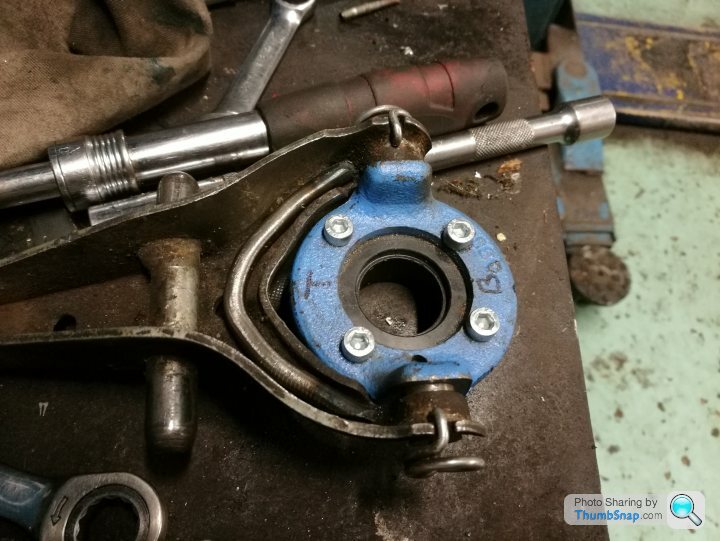
In the interim period, I'd been speaking to a guy who used to race Imps. He said a trick back in the day was to bend a nail and weld it into the inside of the release bearing fork. I didn't fancy that, so I found some M8 studding and used that instead. I've been pretty crap with getting pictures, so this is how it looked to start with. You'll have to take my word that I fitted it!
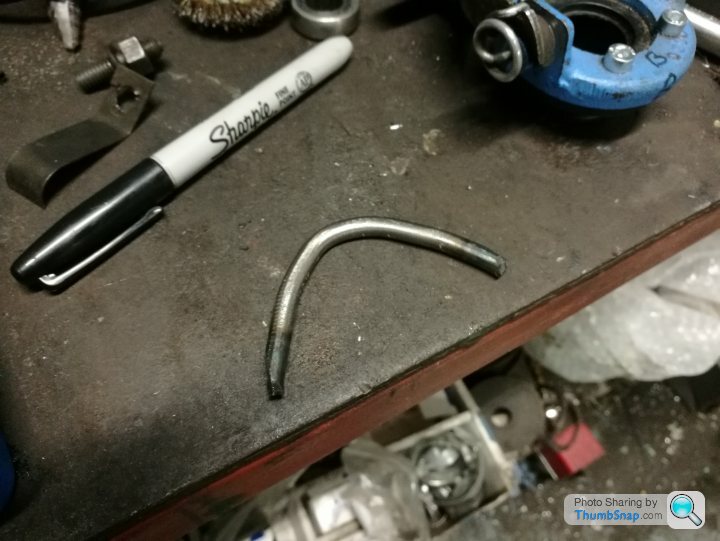
Next step was to modify the top of the arm. Risky business, as I'm now altering the swing ratio, but as I measured before, I need 8mm of movement. The release bearing gives a maximum of 15mm (I think), and through the measurements I worked out I needed 12mm of movement at the slave. I made a new end for the arm, beefed it up pretty much everywhere and finalised the design:
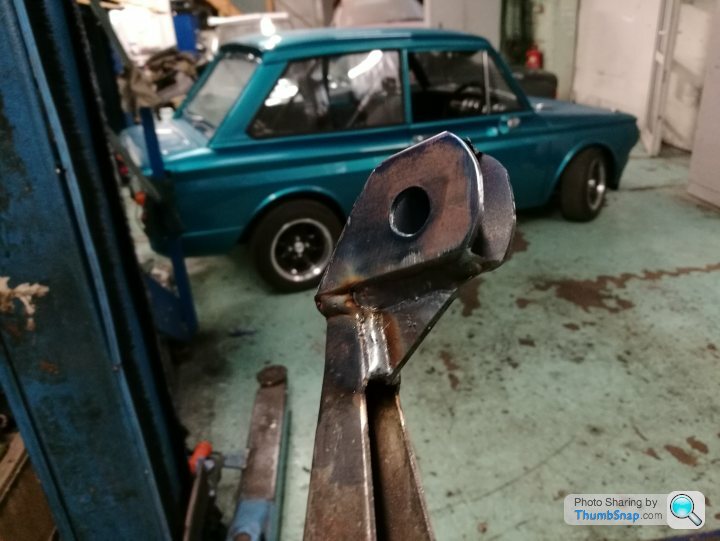
Then it was time to paint and fit, along with the pushrod I made from an old TVR Chimaera clutch master cylinder rod, connected to a rosejoint. I made it adjustable, so as the clutch wears down I can shorten the pushrod to compensate. I don't want to be changing it again for a long time!
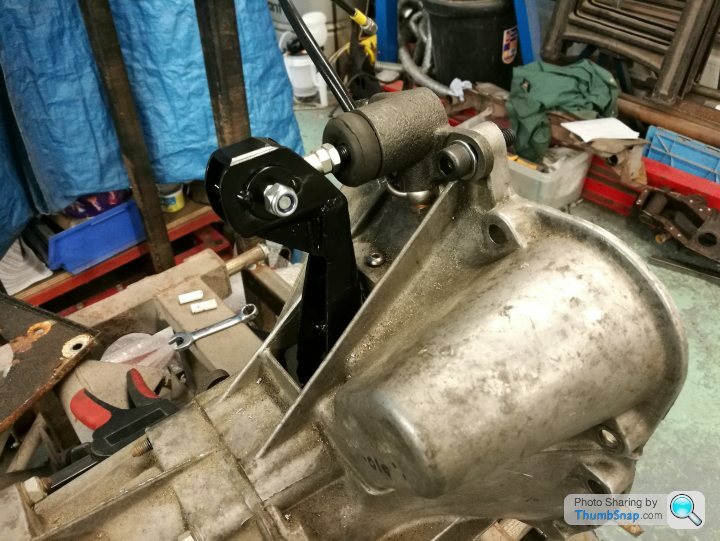
In order to keep the bearing vertical, I managed to come up with a really simple but effective solution right at the end (at the point I was contemplating life with a release bearing that chattered its tits off everytime I pulled up at the lights). All it took, was a spring!
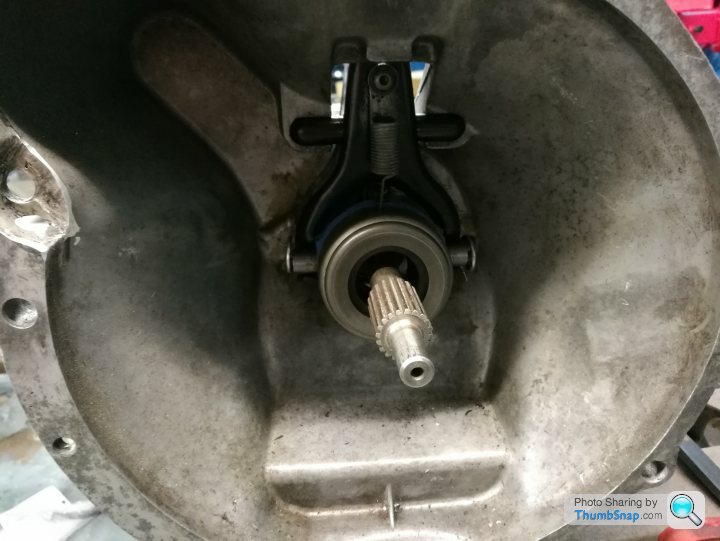
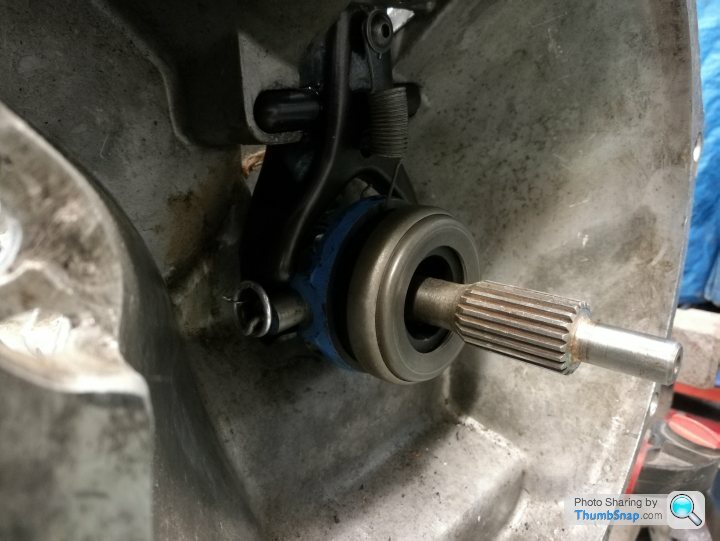
Here it is all fitted and with the retaining springs lockwired in place to stop them dropping out.
So what I ended up with, was a bit of a mis-mash of bits.
Citroen Saxo VTR engine
Hillman Imp mk3 transaxle with a custom input shaft (with Ford splines)
Citroen AX GT flywheel
Citroen AX GT clutch cover
Ford Sierra 1.6 clutch plate (turned down to 180mm)
Fairly heavily modified Hillman Imp release arm
Saab 900 release bearing
MG Midget release bearing housing (with custom delryn boss)
CBS shallow clutch slave cylinder with modified TVR Chimaera actuation rod and HEL braided line
Before I even through about putting it back in, I had to check it all added up. I knew the slave cylinder was the same capacity as the original Imp one, and it was running a standard Imp master cylinder, so the piston ratio should be the same. Only one way to check whether it all works or not.....rig it up!
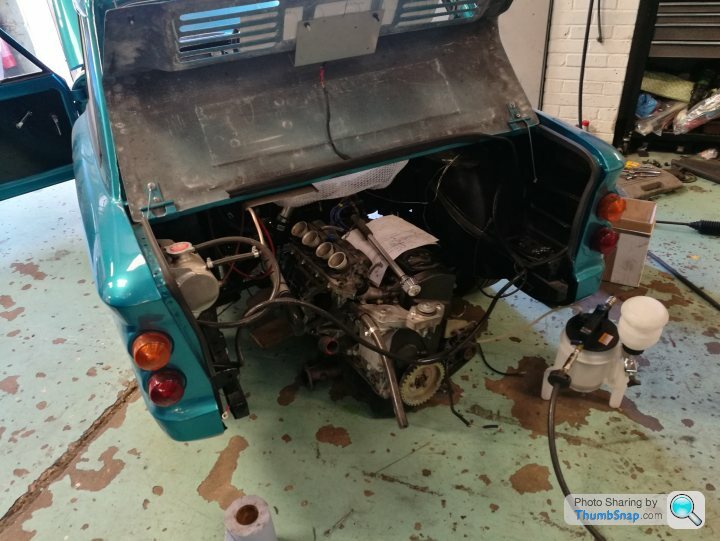
Luckily, thanks to the HEL braided line, I had just about enough spare hose to sit the engine on the floor and bleed it in! It seemed to bleed in OK, and it was operating the arm, so I made the decision to actually fit the engine and see if it worked or not.
I did! I have no picture of the engine back in place yet, but the driveshafts were fitted up and the clutch bled in once more. I put it in gear, tried to rock it backwards and came up against the engine resisting it. I depressed the clutch.....and still it wouldn't move. I sighed, loudly. I pushed harder and realised I could move it, but that it was dragging heavily. I had a feeling there was some air trapped in the system, and suspected the slave as the bleed nipple is mounted at a less than ideal angle. I removed the cylinder, bled it in my hand with the bleed nipple pointing the right way, refitted, tried again.....YES! The clutch was working!
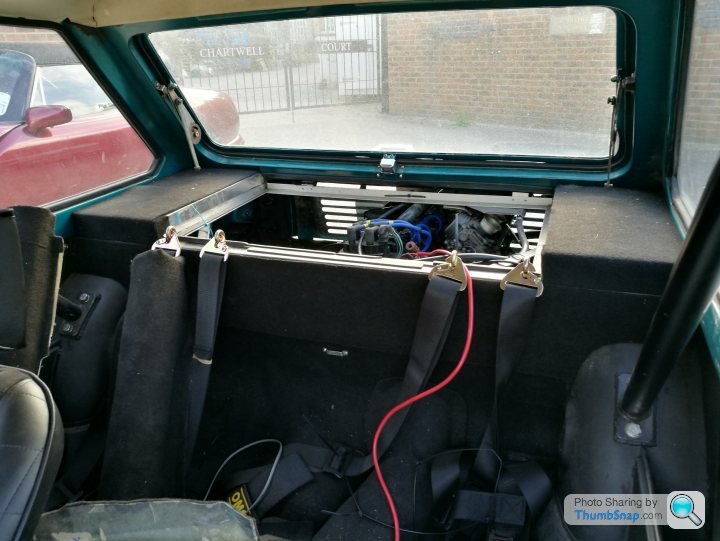
I rigged the engine back up and got it running. I tried to select gears...no problem at all! The pedal is a perfect weight, and the clutch is silent both disengaged and engaged. It actually couldn't have gone better! I took a quick video, which I'll upload to the tube, but early signs are great!
Last time it was on the road, I remember there were some issues which I'll need to resolve, but I've booked an MoT for Thursday, so I'll see if I can get it through and begin testing it. It needs a new battery, and I'm going to fit a proper 063 rather than that stupid cyclic gel thing that goes flat every 5 mins.
In the meantime, I completely forgot I'd applied for a spot at the Goodwood Breakfast Club classic car meet. The Imp's been accepted, so fingers crossed it'll be there on the 6th August
However, progress has, at last, been made! So to pick up where we left off, I had decided to use an original Imp release arm (modified) and mount a slave cylinder externally, as per the original Imp design. I had space issues as the original Imp cylinder lay over the original Imp engine, and because I don't have an original Imp engine, I don't have anywhere for the original Imp slave cylinder to lay. There's a lump of iron where that would go, so a slimline clutch slave cylinder was obtained and fitted.
Initially, we'd been running with a solid spigot bearing (an oilite bush, if we're being pedantic). The first one that went in was awful - too small, and it broke out. The second one that went in last year ended up being too tight on the end of the shaft. Different ideas were floated, before we actually found a supplier of needle-roller bearings in various sizes. The TU engine doesn't use a spigot bearing, as the MA gearbox a Saxo is normally fitted with has the support bearing on the input shaft, but happily there was still a bore hole in the end of the crank, and into that I managed to fit two very lightly greased needle roller bearings:

Another modification made through the process was shaving 0.5kg off the flywheel, by using an AX GT item, rather than the 106 Quiksilver item that was already fitted (the original Saxo VTR setup didn't fit in the bell-housing as it used a bigger clutch). I think the half a kilo saving is purely down to the fact the 106 unit had an enlarged timing ring on the outside of it, presumably for the TDC sensor on an injected engine. This change also necessitated the use of an AX GT clutch cover, rather than the 106 one, but that was fine as I had beaten ten bells of s
 t out of the 106 one trying to remove the gearbox a week or so before!
t out of the 106 one trying to remove the gearbox a week or so before!The AX GT flywheel was refaced, checked for balance and fitted to the VTR engine:

The issue with all this was that I was going to have to space out the release bearing from the housing, which itself just pivoted on the end of the release arm. In a normal Imp, the issue of balance wasn't....well, an issue at all, seeing as the COG of the housing was spot on, and the bearing was actually a carbon bush.
Different ideas were floated around on ways to extend the reach of the bearing (because of the thickness of the adapter, and it causing the gearbox to sit further away from the engine), but without having the issue of the whole assembly tipping over and getting too up close and personal with the clutch cover fingers. That would be a fairly annoying noise!
Eventually, through researching bits on eBay and playing on Google, I arrived at something I thought might work. First step was to obtain an MG Midget (1.3.......I think) release bearing, as seen further above. I then had my business partner turn up a delryn insert, that would fit inside the bearing housing (having removed the carbon bush). I have no decent pics of this, but in this image I'm drilling a tapping it, so that I can fit some small retaining bolts from behind (all they'll do is keep it up against the housing, and stop it trying to rotate in the housing, should the bearing seize up or something:

Here it is with the bolts fitted. I'd love to tell you they're not fitted in an even PCD for a particular reason, but the truth is it was late in the evening, it won't affect how effective it is, and (perhaps crucially) nobody's going to see it...

In the interim period, I'd been speaking to a guy who used to race Imps. He said a trick back in the day was to bend a nail and weld it into the inside of the release bearing fork. I didn't fancy that, so I found some M8 studding and used that instead. I've been pretty crap with getting pictures, so this is how it looked to start with. You'll have to take my word that I fitted it!

Next step was to modify the top of the arm. Risky business, as I'm now altering the swing ratio, but as I measured before, I need 8mm of movement. The release bearing gives a maximum of 15mm (I think), and through the measurements I worked out I needed 12mm of movement at the slave. I made a new end for the arm, beefed it up pretty much everywhere and finalised the design:

Then it was time to paint and fit, along with the pushrod I made from an old TVR Chimaera clutch master cylinder rod, connected to a rosejoint. I made it adjustable, so as the clutch wears down I can shorten the pushrod to compensate. I don't want to be changing it again for a long time!

In order to keep the bearing vertical, I managed to come up with a really simple but effective solution right at the end (at the point I was contemplating life with a release bearing that chattered its tits off everytime I pulled up at the lights). All it took, was a spring!


Here it is all fitted and with the retaining springs lockwired in place to stop them dropping out.
So what I ended up with, was a bit of a mis-mash of bits.
Citroen Saxo VTR engine
Hillman Imp mk3 transaxle with a custom input shaft (with Ford splines)
Citroen AX GT flywheel
Citroen AX GT clutch cover
Ford Sierra 1.6 clutch plate (turned down to 180mm)
Fairly heavily modified Hillman Imp release arm
Saab 900 release bearing
MG Midget release bearing housing (with custom delryn boss)
CBS shallow clutch slave cylinder with modified TVR Chimaera actuation rod and HEL braided line
Before I even through about putting it back in, I had to check it all added up. I knew the slave cylinder was the same capacity as the original Imp one, and it was running a standard Imp master cylinder, so the piston ratio should be the same. Only one way to check whether it all works or not.....rig it up!

Luckily, thanks to the HEL braided line, I had just about enough spare hose to sit the engine on the floor and bleed it in! It seemed to bleed in OK, and it was operating the arm, so I made the decision to actually fit the engine and see if it worked or not.
I did! I have no picture of the engine back in place yet, but the driveshafts were fitted up and the clutch bled in once more. I put it in gear, tried to rock it backwards and came up against the engine resisting it. I depressed the clutch.....and still it wouldn't move. I sighed, loudly. I pushed harder and realised I could move it, but that it was dragging heavily. I had a feeling there was some air trapped in the system, and suspected the slave as the bleed nipple is mounted at a less than ideal angle. I removed the cylinder, bled it in my hand with the bleed nipple pointing the right way, refitted, tried again.....YES! The clutch was working!

I rigged the engine back up and got it running. I tried to select gears...no problem at all! The pedal is a perfect weight, and the clutch is silent both disengaged and engaged. It actually couldn't have gone better! I took a quick video, which I'll upload to the tube, but early signs are great!
Last time it was on the road, I remember there were some issues which I'll need to resolve, but I've booked an MoT for Thursday, so I'll see if I can get it through and begin testing it. It needs a new battery, and I'm going to fit a proper 063 rather than that stupid cyclic gel thing that goes flat every 5 mins.
In the meantime, I completely forgot I'd applied for a spot at the Goodwood Breakfast Club classic car meet. The Imp's been accepted, so fingers crossed it'll be there on the 6th August

lufbramatt said:
Really enjoyed reading through all this, ingenious fix for the clutch, looking forward to more!
Thanks for sharing
Cheers Thanks for sharing

 The clutch spring idea came to me just as I was about to put it all back together. Seemed so simple, and so daft that I hadn't thought of it already!
The clutch spring idea came to me just as I was about to put it all back together. Seemed so simple, and so daft that I hadn't thought of it already!Mark Benson said:
I do enjoy your updates (and the determination to make everything you do Gallic in some way).
Ha! There was genuinely no intention to inject any Gallic-ness into the Imp. Originally when the idea behind the car was conceived, it was a candidate on a list of potential engines that actually began to make sense the more we thought about it. And then there was the tenuous Rootes > PSA link (which goes around the houses a bit).MoT is later today at 4pm. Actually more nervous than I normally am!
gert biggens said:
You know there have been many, many, many fine cars brought to my attention of this forum, spanning the sublime to the absolute Barry. But this project I think, aside from being incredible, represents the absolute encapsulation of the PH spirit. So much love, ingenuity, craftsmanship, creativity and man-hours has gone into a project that makes no logical or financial sense whatever, and yet it just lifts the spirits to see it. To take an Imp, which, let’s be honest, looks great, but never quite had the engineering underneath that it should have had… and then just roll up your sleeves and GIVE it all that, with lathes and hammers and bits of dead other cars…
…Kitchski, I salute you, and all who sail in you!
Kind words Mr Biggens! Obviously the idea of the car was down to Tim, the previous owner. I just made it happen, but yes it probably was fairly pointless to build it. …Kitchski, I salute you, and all who sail in you!
The Imp as a car is actually a well-engineered thing, in my opinion. You find lots of little touches and features, and the way they drive for a car of that age is really impressive. The bad side is that you get the feeling the designers and engineers were on a decent wage, but that the accountants had quite a big say in the direction of the project. The workforce were probably on minimum wage, and I think they'd probably just had their mid-morning coffee break slashed by 5mins the day before they put mine together

I genuinely do think the Imp is a very good little car. The Mini was a technical marvel, but the Imp was ahead in many respects (admittedly not THE one single advancement the Mini brought). It's a shame they were underdeveloped so much, but there's an interesting history to them.
darkyoung1000 said:
A splendid thread from the start, I love how the Imp has ended up.
Really nice work on getting it that tidily fettled!
Cheers,
Tom
Thanks Tom Really nice work on getting it that tidily fettled!
Cheers,
Tom

CarlosV8 said:
So how did the MOT go??
You're on my Facebook Carl, you must know! 
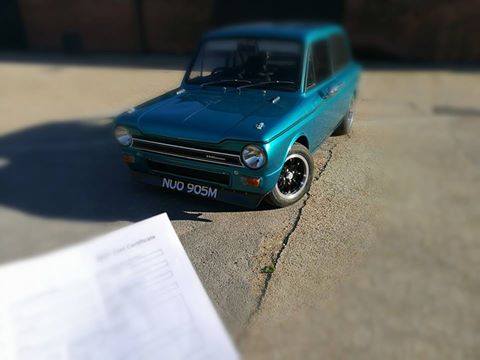
Straight through. Picked up an advisory on the kingpins, which it had last time (but in reality it's done about 60miles since then, though the speedo says 170 because it was overreading as we hadn't done a good job designing the speedo pickup). Otherwise, no issues, though the tester did say that so much of the test isn't applicable to a car of that age it's almost pointless doing it!
I had brought my TVR into work yesterday morning to get it ready for the Uxbridge car show on the weekend, where the TVR S group have a stand. That meant that, practically speaking, I needed to leave it in the workshop where the Imp normally lives (I've got so many cars they float around - I'm never totally sure where they all are!) So, MoT in hand (and quite a few aspects of the car not fully finished) I decided to drive the car home. I live 4 miles from work, and spent the first mile getting the speedo adjusted fully (now reading 1mph over). I spent the following 8 miles (slight detour) grinning like a loon. I arrived at home yesterday around 7pm, and to be honest I was buzzing! That feeling where you've just done something fun, and then you suddenly stop, leaving you at a bit of a dead end for the next 30mins!
It's so much smaller even than the TVR. Ideal sized for a tiny garage (going to be fun getting the BX back in there):
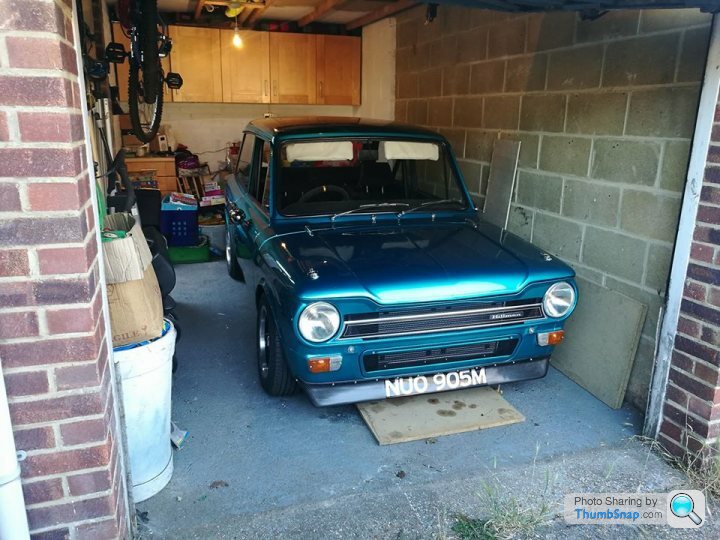
I'd just forgotten how much fun it was. It's very noisy, very frantic and very fun. The gearing is so short that if you put your foot down in 2nd or 3rd it really pins you back in the seat! It sounds mental, and angry, and yet it only lasts a few seconds as you run out of revs (because of the short gearing). You work up a sweat baaaaaarping and banging and making 1970's rally car noises, and then you get home, look at your GPS app on your phone to check the mileage is correct and find that you didn't exceed 52mph! I never broke the law, yet I was grinning like a Cheshire cat! Probably because I got to 52mph so quickly...
I'm going to make a list of things to sort out. I junked the small gel battery and went for a proper 063, but I need to find somewhere decent to fit it and secure it properly. The brakes need bleeding again as they're really poor (I hope that's not 'how they are', and then there's the bodywork to sort out. I'm also planning on giving the interior a revamp.
You know, just with all that spare time I spend kicking around doing nothing....
The downside of this car is the attention it gets. I like my TVR....its grey. Nobody looks at it. The BX is great, because the only people who notice it are those who know what it is and appreciate it, so you filter the wheat from the chaff.
This thing? Christ. Everybody looks, either because it stands out visually (I'm fairly immune to the way it looks because I'm so used to it, but on the road it might stick out like a sore thumb), or because they hear it coming (it's pretty noisy).
I don't like drawing attention, so from that point of view it's not great! That said, at least the attention is normally positive. If it were a supercar or something, you'd get loads of abuse too, but with this it's too cute and friendly. Like a Moggy Minor
This thing? Christ. Everybody looks, either because it stands out visually (I'm fairly immune to the way it looks because I'm so used to it, but on the road it might stick out like a sore thumb), or because they hear it coming (it's pretty noisy).
I don't like drawing attention, so from that point of view it's not great! That said, at least the attention is normally positive. If it were a supercar or something, you'd get loads of abuse too, but with this it's too cute and friendly. Like a Moggy Minor

Gassing Station | Readers' Cars | Top of Page | What's New | My Stuff





